



Featured image: Gramophone Transmissions original artwork
Broken Harbour is an ambient project from Edmonton’s Blake Gibson, with two self-released albums to date available through various digital outlets. The more recent, Gramophone Transmissions, is composed largely from samples after a growing dissatisfaction with synthesizers. His source material included classical music from worn-out vinyl, CDs and cassettes, as well as some recordings of his own on voice, piano, and, mellotron. Overlaid with a vinyl patina, Gramophone Transmissions mines the surreal territories somewhere between Leyland Kirby and William Basinski, evoking musical memory through harmonies sustained and overlapped, and melodies whose contours have been worn smooth from forgetfulness and decay.
The first half of the album sets the stage with long, slow pulses, The opening track “Drift” features a short, delicate, and elegant piano run, which gave it a sparkle, a twinkle of light. But the piano becomes a glimmer, hovering in distant chords as the album progresses inevitably to a darker, more nocturnal climate, an increasingly featureless audio plain constructed from low strings and cavernous reverberation. A last lingering appearance comes as a channel bell in “Titan”, a repeated warning sounding through the fog, fraught with mythological overtones.
Modafinil (also known as Provigil) is medication used to increase wakefulness in those with sleep disorders, such as narcolepsy, sleep apnea, and shift work sleep disorder. To buy it, you’ll need to have a doctor’s prescription.
Buy Modafinil 200mg Online (buyprovigil) on BuzzFeed. Modafinil is a drug developed for the treatment of extreme lethargy. Despite being proven its effectiveness in the intervention of sleep …
The album’s second half, its three longest tracks, start with “Dark Clouds Approaching From The West,” full of murk and distant rumbles, seeking the tension in the faraway twilight storms without ever finding a release. “Maelstrom”‘s discordant voices will probably awaken anyone unwise enough to fall asleep to the previous lulling tracks. Its fleeting and wavering high strings introduce a slowly evolving series of shifting textures full of foreboding. The closer, “Unforeseen Consequences,” hangs on a single sonority forever before returning to the quietly evolving moods of the earlier tracks.
Periphery is a new name for the electronic music trainspotter. Ideated by Darren Bergstein, editor of late lamented e|i mag, site of manifold musings on electronic music and otherwise, it follows a successful series of live events staged in his home under the One Thousand Pulses banner. The transition to label status is effected via three initial releases. First, The Electric Golem – vintage electronics maven Trevor Pinch on Moog Prodigy and James Spitznagel on iPad and digital synthesizers, ipod touch, nintendo DSi, Tenori-on – with Sky Snails, three lengthy pieces of rampant electronics wrangling, surfing cosmic and Radiophonic workshop sinewaves; a one-take affair seemingly based on semi-structured shells within which there is stretch-out space; case in point the final slab of interstellar overdrive, “Sky Snails Part Two.” “What Watson Doesn’t Know” is more harmonized of habit, getting some 4/4 kicks in taking a neo-techno turn on the way. Elsewhere Space Noise medley “Sky Snails Part One” continues the allusion to Cosmic music, though Pinch and Spitznagel veer from the more recondite to more hyperactive circuit-bending, aligning them closer to the untidier experimental end of avant and computer music.
Pinch believes that while classic synthesizers ‘are able to produce weird and unexpected sounds … Jim’s iPad and modern digital synthesizers are more precise… The sound can be changed much quicker … from bell sound to mellotron to horn.’ And it is perhaps this balance of classic analogue and contemporary digital, of chaos and indeterminacy commingling with the clear and precise that gives The Electric Golem its timbral identity. Yes, Sky Snails is, above all, an album for those who enjoy the jouissance of being patched into a grid of cables, knobs, and circuit boards, but in a climate of bandwagon-jumping Kosmische appropriation, it’s refreshing to hear something more adventurous wrought with analogue synths other than hypnagogue wibble and cloud watching.
(for more on the Periphery, see Polychromatic Integers and Home Patterning)
The Philosophy Of Software
Code and Mediation in the Digital Age
David M Berry
Palgrave Macmillan, 2011
ISBN 9780230244184
http://lab.softwarestudies.com/2011/04/new-book-philosophy-of-software-code.html
“The Philosophy Of Software” is an ambitious book by David Berry, who has turned his attention from the social relations and ideology of software (in “Rip, Mix, Burn”, 2008) to the question of what software means in itself. The philosophy that he has in mind isn’t the mindless political libertarianism attributed to hackers or the twentieth-century foundational mathematics that is the basis for the structure of many programming languages. It is a serious and literate philosophical reading of software and its production.
Software is an important feature of contemporary society that is rarely considered as a phenomena in its own right by philosophers. Software permeates contemporary society, Berry gives the examples of Google’s profits and the “financialisation” of the economy through software as examples of software’s importance in this respect. In reading this review on a screen you have used maybe a dozen computers, each containing multiple programs and libraries of software directly involved in serving up this page. Digital art and cyberculture often use and discuss software and philosophy (or at least Theory), but usually to illustrate a point about something other than software. The software itself is rarely the subject.
Rather than devote each chapter to a different philosopher’s views on software or adopting a pre-existing description of software Berry develops a novel and insightful philosophical approach to understanding and considering software. After providing an introduction to the foundational ideas and culture of software (Turing, Manovich, Cyberpunk), Berry presents a way of thinking through different aspect of software. The source code, the comments, the compiled program. Each stage and product of the lifecycle of software is given a philosophical context.
Heidegger emerges as the philosopher whose ideas first underwrite Berry’s approach to software. Latour and, in a surprising way, Lyotard play pivotal roles in later chapters. If these are not philosophers you were well inclined towards before then you are in for a pleasant surprise.
Berry presents some typographically appealing and culturally interesting code in order to demonstrate different features of the production of software. The swearing placed in Microsoft’s Windows source code comments by its programmers will mirror the frustration of many of its users. The Diebold voting machine code that illustrates the assumed social and gender roles of its human subjects show that code is very much a product of the social biases of its human authors.
Much of the code illustrated in the book is code poetry or obfuscated code. These are double-coded programs, where source code that can be run by a computer is written and formatted to be not just understandable but evocative and meaningful to human readers as something read rather than run. As with the comments in the Windows and Diebold code, a criticism that might be levelled at such code is that such textual decoration does not affect the compiled (or executed) form of the code.
But comments and formatting are what Berry refers to as commentary code and delegated code in his grammar of code. It has been said that code is written primarily for human beings to read and only secondarily for computers to execute, and obfuscated or poetic code is regarded as high art by many programmers. It must exemplify some of code’s salient features to them, and so it can be used to do so to a more general audience. And the cultural assumptions of code can survive from its source code into its execution and interface: witness the relief of many of Diaspora’s users than “Gender” was a free-form text field rather than a simple binary choice of “Male” or “Female”.
The final chapter on network streams provides a strong critical philosophy of social networking and other software that reduces human experience to a stream of software representations of events. After discussing what it means for a human being to be a “good stream”, Husserl’s idea of “comets” as a precedent for lifestreams and Lyotard’s idea of the stream (both of which predate the streams of the Internet by many years), Berry presents the idea of Dark Streams as a way of resisting the demands of Web 2.0. I would single this out as the most timely and invigoration section of the book and a must-read for anyone involved in producing, consuming, or critiquing networked software culture.
What doesn’t the book cover? There is no visual coding or livecoding. Berry explicitly avoids “screen essentialism”, where the output of code is concentrated on to the exclusion of its production and execution, but despite following programs from their writing through compilation to first assembly code then machine language, running software and algorithms (at the micro level) are not considered, nor (at the macro level) are the architectures of applications or of operating systems. Nor is testing except in passing. But this fits with the emphasis of the book on code as text, and the framework that it provides can be extended to these topics. Hopefully by Berry.
“The Philosophy Of Software” is particularly inspiring as a spur to further research. Each page is brimming with references in the style of the academic papers that many of the chapters were first produced as and whilst this style can be distracting at first (compared with popular science books for example) it is ultimately rewarding and gives the reader any number of fascinating leads to follow up.
What is important about “The Philosophy Of Software” is that it really is about what it claims to be about. Rather than trying to shoehorn software into an existing philosophical or political agenda it considers software as a thing in itself and finds those philosophers and philosophical ideas that best address the vitally important phenomenon of software. However much philosophy, computer science or cybercultural theory you may know this is a book that will set you thinking about software anew.
The text of this review is licenced under the Creative Commons BY-SA 3.0 Licence.
Peter Lunenfeld’s book “The Secret War Between Downloading & Uploading: Tales Of The Computer As Culture Machine” (MIT Press 2011) presents a new way of looking at the cultural struggle for control of the Internet. Although the conflict between uploading and downloading may not seem secret since the Napster case a decade ago, and is indeed a common feature of net political debate, Lunenfeld is using the concepts of downloading and uploading to discuss not the copyfight but how human beings relate to each other culturally and socially through technology.
Lunenfeld immediately establishes both technical and poetic meanings for each term. Downloading is fetching data from a central server, or an animal eating. Uploading is sending data to a server and to other devices. It is also animal excretion and nesting, and the human creation of “superfluous” material goods such as paintings and experiences such as philosophy. Downloading for Lunenfeld is consumption, and in its current state dominated by broadcast media it is overconsumption leading to “cultural diabetes” in which mass culture plays the role of high fructose corn syrup (HFCS).
This is vivid, but the very definition of uploading that Lunenfeld starts with (sending data to other devices) also involves downloading (…to other devices). The “slow food” movement that he contrasts with super-sized, HFCS-laden American diets is a product of broadcast culture like any other hipster franchise. And outside the US, HFCS has never replaced sugar and state and independent television has provided an alternative to the HFCS of the brain that he describes network television as. If I am critical of this, and a (very) few of Lunenfeld’s other arguments, it is only because of the clarity with which the rest of them are presented and with which they are all developed. This is a serious, ambitious and forward-looking book about human use of networked computing machinery in an age when cybercultural lullabies and recanting cyberprophets have turned the field into an inward- and backward-looking one. It deserves serious critique.
As the subtitle of the book, “Tales Of The Computer As Culture Machine”, claims the computer, and particularly the networked computer, is indeed a culture machine. Computing machinery can imitate any other machine, and so any mechanically reproducible media (that is to say, all mass media) can be created, distributed and reproduced by computers. That the wide availability of computers and network access changes the balance of power in the media is a common claim, and one that it is easy to view cynically in the face of an Internet of lolcats and conspiracy theory blogs. But Lunenfeld takes us beyond this.
Lunenfeld builds up concepts and weaves them together into a coherent and thought-provoking worldview. Affordances, mindfulness, information triage, sticky vs. teflon objects, tweaking, toggling, continual partial production, unfinish, WYMIWYM, MaSAI. Some of these are standard in cyberculture and its critiques. Others are Lunenfeld’s own coinage. They build up to form a new vocabulary and a conceptual framework for new critical take on network culture. And, crucially, new possibilities for action on the basis of that critique. Like all the best Theory, Lunenfeld’s concepts identify something important in the real world and afford new ways of thinking about it and acting on it.
Having exhorted us to download mindfully through info-triage and to upload meaningfully, to make unimodernist media sticky and unfinished and to move beyond the revolutionary rhetoric of Web 2.0 to an evolutionary Web n.0, Lunenfeld describes a world of bespoke futures (“Creatively misusing scenario planning as a means toward crafting visions of the future”) and plutopian meliorism (the pluralistic pursuit of happiness within an open society).
The ultimate destination that emerges in the final pages of this new take on network culture is surprisingly high stakes. It is nothing less than an appeal to use the means of the aesthetics of the culture machine to pursue the ends of plutopian meliorism in the face of the closures of would-be theocrats and other totalitarians. That is, to use the net to reaffirm the enlightenment in all its ambition and seriousness leavened with and strengthened by the pluralism of postmodernism’s critique of modernity.
Is the framework that Lunenfeld has built up in the course of the book up to this task? Can it be used to address left and right-wing criticism from within and without mainstream Western society that Western culture is just, well, entertainment? Lunenfeld’s achievement is to build his framework from many small measures that can easily be applied practically and evaluated against vivid concepts. By the end of the book you can see how to act on this and to evaluate whether your actions succeed. And the effects of those actions, although not revolutionary (and Lunenfeld rightly points out that the rhetoric of revolution has been appropriated by theocratic and corporate reaction), will be in the direction of considered lives in a society that is more than simply entertainment as a result.
Lunenfeld finishes the main argument of the book by proclaiming that he will write utilities rather than manifestos. But he has written a fine example of both here: a call to action with a conceptual and practical toolkit to support it. With cyberculture at its most nostalgic and despondent at precisely the moment where network culture is showing its potential for both progressive and reactionary political change, the modesty of Lunenfeld’s means and the ambition of his ends are a much needed and easily embraced positive step forwards.
http://mitpress.mit.edu/catalog/item/default.asp?ttype=2&tid=12452
The text of this review is licenced under the Creative Commons BY-SA 3.0 Licence.
Featured image: Healing Station. mixed media, interactive installation, size variable. Christy Matson and Jon Brumit, 2009.
The New Materiality: Digital Dialogues at the Boundaries of Contemporary Craft.
March 10–June 12, 2011
Decorative Arts Gallery
http://www.mam.org/exhibitions/details/new-materiality.php
For the first half of the 20th century, curator Fo Wilson reminds us, the practice of craft was heralded as a “remedy” to how human values were changed by the Industrial Age. Here the hand-made was given privileged status over the machine-made, and thus craft forms gifted new value through the artisan. In the latter part of the last century, as the world moved from apprenticeship and artisanship to a more intellectual and theoretical-based framework for valuing contemporary art, so too have craft practices and discourses been challenged. This rethinking of craft has accelerated in the last several years, with books like Glenn Adamson’s Thinking Through Craft and Howard Risatti’s A New Theory of Craft (both 2007), both arguing for conceptual rigor and provocative possibilities within craft as a discipline.
The New Materiality: Digital Dialogues at the Boundaries of Contemporary Craft, an exhibition that began at the Fuller Craft Museum and is currently up at the Milwaukee Art Museum (MAM) until June 12, follows on and extends current trends in contemporary craft. It engages not only with craft’s reinvigoration as a creative practice and discourse, but with how these have been shaped by, and also transformed, new technologies, new designs, new materials and new ideas. Wilson’s exhibition and events make discussions around Art or Craft, Art or Design, Digital or Hand-made, and Conceptual or not seem, in a word, quaint; she engages with a broad set of materialized ideas that divide and relate across the artistry of craft, the ephemera of technology, and the theoretical frames of post-conceptual art.
The exhibition can perhaps best be summarized through the work of the four exhibiting artists/artist teams that spoke at the “Dialogues on Innovation” panel at the Milwaukee Art Museum on April 16th. Collaborative artists Donald Fortescue and Lawrence LaBianca, for example, spoke to Milwaukee activist and printmaker Nicholas Lampert about their piece, Sounding. This work consists of a huge, custom built cabriole-legged table, which was initially filled with beach rocks and sunk to the bottom of the ocean. There it lay, for two months, with a hydrophone to record the ambient sounds of the sea, including the overwhelming swish of waves, the low hum of slow-moving current, and the activity of sea life – the most prominent being the continuous clicks of what must be shrimp in its vicinity. When the artists’ creation reemerged, it brought the bottom of the ocean with it: all the messiness and stink and poetry of the sea – barnacles, rusty parts, plant life, fish scents, mystery and more. It is exhibited with an over sized hornlike funnel, a huge phonograph tied together with zip ties, to amplify the recorded sound.
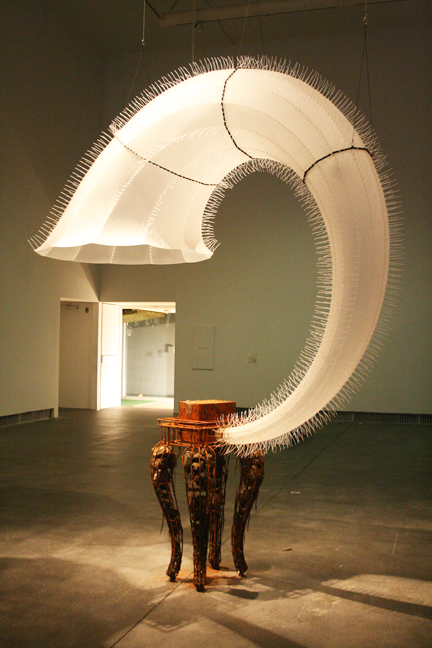
Sounding, avowedly inspired by Captain Ahab’s hunt for an un-killable whale, acts as a kind of parallel to the ongoing hunt for singular disciplinary focus in craft. The piece dives into the sea, hits “rock bottom,” and looks as if it barely survived; and on its return, we see that Sounding is far from a singular entity. Yes, it is trashed and torn, but it’s also imbued with literal life, entwined with technical innovation, and rich with stories of its journeys. Like the theories and practices behind the current craft movements, it came back more beautiful, more visceral, more sensory, and more technological than it ever was: a new materiality.
You can listen to or download Sounding file here:
http://www.furtherfield.org/audio/Soundings-1.mp3
My discussion with artist Christy Matson revealed an exploratory practice that shifts between digital and hand-made, generative and interactive, and always with an eye towards the implications of each. Soundw(e)ave, her piece on show, is a self-referential textile, where the actual sounds of computerized Jacquard looms were used to create woven compositions. Her noisy sound waves were turned into three patterned pieces of fabric, made by hand-operated, computer-assisted and fully automated (Jacquard) looms, respectively – each weave growing progressively denser with the more advanced technologies used in their production. The piece, says Matson, was a huge turning point in her practice; it pointed her towards a kind of digital craftsmanship, where she was better able to place value on the ideas, materials and skillfulness needed to be an artisan across contemporary digital, craft and art domains.

Soundw(e)ave, generative weaves, triptych (each 34″ x 54″). Christy Matson, 2004.
For example, Matson then began weaving copper wire directly into her fabrics, and, using the magnetic waves our interactions generate and alter, engendered new aural compositions. In other words, her sonic sculpture turns cloth into a Theremin, where movement and hand-waving at the gallery are transformed into the kinds of musical gestures often associated with science-fiction films of the seventies. While Matson’s earlier, sound-generated works were generative and performative on some level, here she moves into real-time interaction, invoking our embodied relations to textiles, craft, technology and language, all in one fell swoop.
healing station, a collaboration with Jon Brumit and quite possibly the most complex of Matson’s installations thus far, sees piezo sensors placed inside of swaths of fabric to pick up the ambient sounds of the room – including gallery-goers, passersby, street sounds, and the minute vibrations in the fabric itself. This lovely noise is then fed back into the space with bass shakers: speakers optimized for sending waves into solid media rather than air. Viewers can literally feel the low hum of presence, absence and movement as the textile, bodies and room speak at and to one another in a perpetual feedback loop of embodied music. The small crowd at the MAM laughed along with Matson when she relayed a story in which her wired-up piece, and its feedback, caused a small fire at one of its showings – quite a performance, indeed.
Tim Tate artfully explained to Milwaukee staple Tom Bamberger that nowadays “craft” is a starting point rather than an end point. I’m paraphrasing here, but he treats craft as an approach, a space of understanding materials, what they’re good at, perhaps their “habits,” and most certainly their implications. Here, narrative, function and the conceptual are always already implicated across technique – whether new or old – and value is derived from a contextual corpus.
Tate’s work is itself a beautifully resolved hodgepodge of hand-blown glass, hi-tech LCD screens, and visceral videos of typewriters and books, all literally tied together with plastic (zip ties again – don’t knock it ‘til you try it!) around a printed circuit board. In Virtual Novelist, for example, miniature monitors display the aforementioned “dead media” tools from behind artefactual casings of glass. Atop are beguiling sculptural homages to each of the gone-but-not-forgotten analog recording devices of yesteryear.
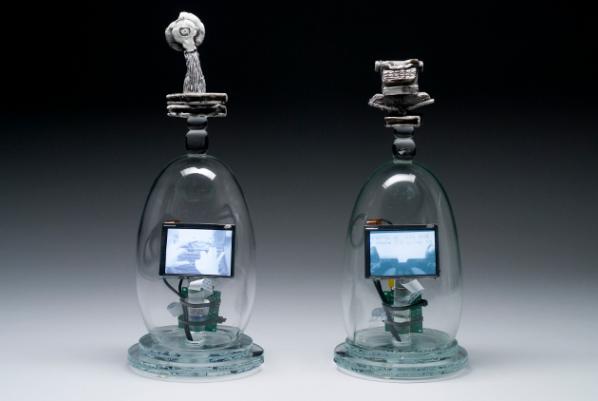
Bamberger is a smart artist with a quick wit, and Tate is similarly not one to spar with unless you have a good grasp of the discourses at hand. In this lively thirty-minute discussion, the two managed to disarm the Art vs Craft debate as both unproductive and long-since over, and open up possibilities for “ornamental aesthetics” in time-based media. Here the implication was that, following Tate’s lead, video objects and installations could place more emphasis on the object and installation – rather than the video – and use each as an equal material that informs and plays off of the other; the video and screen need not be the central focus.
Sonya Clark then told us how she views her practice as a fiber artist as similar to how author Toni Morrison views her own writing practices. In one of her essays (found in several publications, including a collection entitled What Moves at the Margin), the latter tells a story of the Mississippi River, which was laboriously straightened for travel and transport by boat. Every so often, the river floods; but, Morrison goes on, it’s not really flooding. It is remembering. The water is trying to get to where it belongs, to re-member, to embody again. Morrison says writers do the same with their texts; and Clark claims that she remembers through her materials. Originally trained as a fiber artist and now working across found objects, digital art and more, Clark’s practice sees her reclaiming forgotten histories, and giving them greater potency through her processes and media.
Clark discussed this approach with longtime friend and former colleague, UW-Madison Professor Henry J. Drewal – one of the foremost thinkers surrounding African Art. Clark’s brilliant work on the exhibition, a portrait of Madam CJ Walker, is constructed entirely out of small, acrylic and thin toothed, black hair combs. She overlays the combs and removes some of their teeth to make a huge, grayscale, and literally bit-mapped image.
Madam Walker, the first ever female millionaire in America (and African American to boot), made her fortune selling beauty products to black women hoping to straighten their hair – as was the fashion of the time. And so Clark utilizes her combs, with their own memory, narrative and political weight, to construct a lo-resolution digital image. This exceptional work manages to explicitly straddle issues of race, gender, class, memory and materiality on its very tactile surface, and implicitly engage with the contemporary conceptual frames of digital art and data, in its transcoding of the image from one form to another, and craft, in the final material and hand-made form it takes.
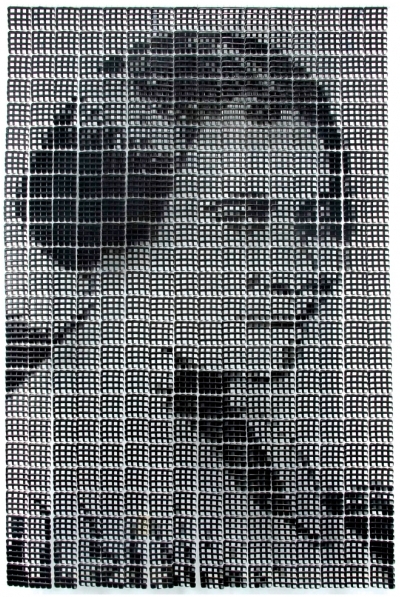
Clark finished with the generous idea that, at present, all art work is collaborative in that it fits into broad social and cultural contexts, builds on extant technologies, and is produced, received, and engaged with outside of the individual’s studio. And Drewal concluded by declaring that technology has always been at center of the arts in the form of new techniques. When something comes into the world, he went on, whether technical or formal or as an image, artists take it someplace else. They “turn common objects… into uncommon things, stretching our imagination and the world” along with them.
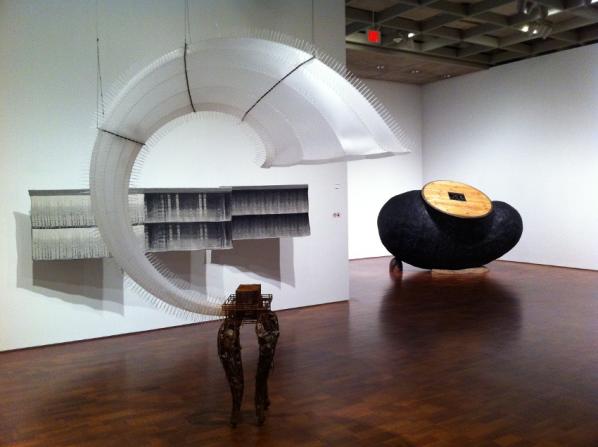
These are just a handful of the works in The New Materiality, by four of the artists represented in our discussions – not even all the works they contributed, much less those of the other artists, which include Brian Boldon, Shaun Bullens, Lia Cook, E.G. Crichton, Maaike Evers, Wendy Maruyama, Cat Mazza, Nathalie Miebach, Mike Simonian, Susan Working, and Mark Zirpel.
It is a show that, in its entirety, succeeds in stretching our imagination, through its expansion of craft, art and digital forms, and what they individually and collectively mean today.
Nathaniel Stern (USA / South Africa) is an experimental installation and video artist, net.artist, printmaker and writer. He has produced and collaborated on projects ranging from interactive and immersive environments, mixed reality art and multimedia physical theatre performances, to digital and traditional printmaking, concrete sculpture and slam poetry http://nathanielstern.com.
‘Made Real’, an exhibition by Scott Kildall and Nathaniel Stern, the founders of Wikipedia Art. Can be seen at Furtherfield’s Gallery from 27th May 2011 http://www.furtherfield.org/exhibition/made-real
“Does Lara Croft Wear Fake Polygons?” that was the question Anne-Marie Schleiner (http://www.opensorcery.net) asked in a gender analysis essay of the popular videogame Tomb Raider published year 2000 in the Switch magazine.
The videogame Tomb Raider was released by Core Design in 1996 and the heroine a British archaeologist named Lara Croft did not only have big guns but also big breasts. In a couple of years she became a well known character not only in the games world but also for the general public when she entered the silvercreen, played by Angelina Jolie. You could say that Lara Croft is the Mona Lisa of the game world, beautiful, mysterious and well known for a large audience outside the games world.
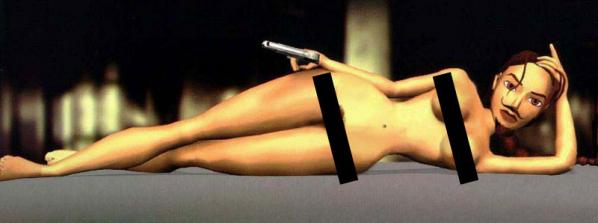
In her essay Anne-Marie Schleiner mentions the famous Nuderaider patch, a game add-on that strips Lara Croft’s clothing so you could play her naked.
The artist Robert Nideffer’s Nuderaider patch made in 1999 consisted of three-parts:
1) an appropriated website where he repurposed the existing commercial site
2) a spoofed mail-server that re-routed messages submit to Lara Croft fan club website to the Director of development at Eidos UK as if it were coming from the Director of Marketing in the US branch
3) a patched version of the Nude Raider patch, which placed police blotter style bar codes across Lara’s private parts (and gave her a goatee as a Duchampian homage), thwarting the game player’s expectation of seeing her polygonal private parts.
“This shows the male dominancy within the game world by having a female lead appearing like a super model. By presenting her naked, it makes the game seem satirical just pushing the creators’ ideas a little further.” Nideffer [2]
In 1919 the artist Marcel Duchamp used a cheap postcard-sized reproduction of Leonardo da Vincis famous painting Mona Lisa on which he drew a moustache and a goatee, in the same way Nideffer later did with Lara Croft. Duchamp called his work L.H.O.O.Q a titled that pronounced in French should be “Elle a chaud au cul”, which translated to English means “She has a hot ass”.
Eidos sent cease and desist letters to the owners of nuderaider.com who were hosting the Nude Raider patch, enforcing their copyright of Tomb Raider.[3]
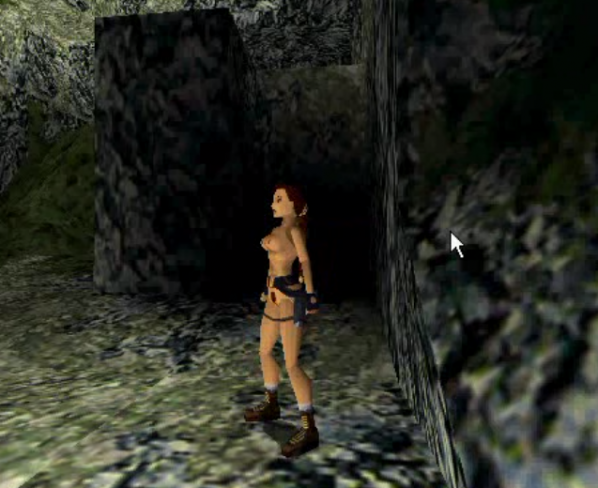
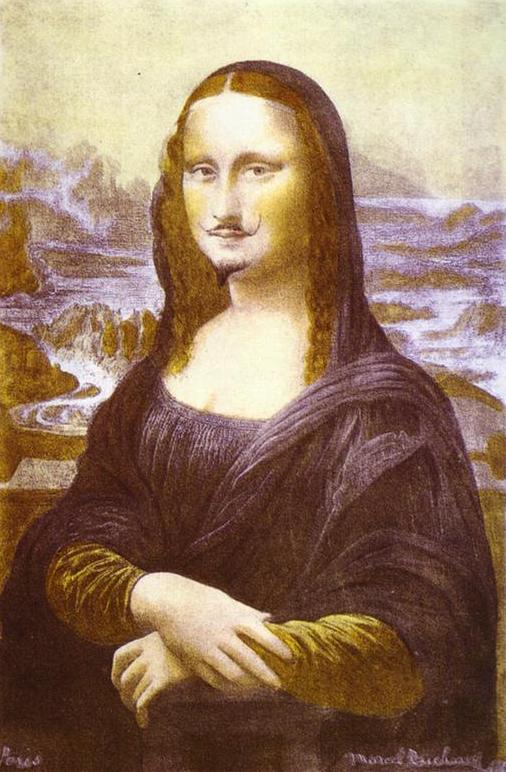
In the machinima “She Puppet” from 2001, the American artist Peggy Aswesh also investigates the gender and cultural identities of Lara Croft by mixing scenes from the Tomb Raider game. Aswesh describes Croft as a virtual girl-doll of the late 20th century, perhaps boy-doll would be a better description since most of the player of the early Tomb Raider games were men or boys. In her essay Schleiner makes the observation that Lara Croft is a “well-trained techno-puppet created by and for the male gaze.” It’s obvious that the videogame Tomb Raider has played a major role in stirring up emotions with its out of date and suspect attitude towards women. But Lara Croft has not only been a subject for critically engaged, artistic gender discussions.
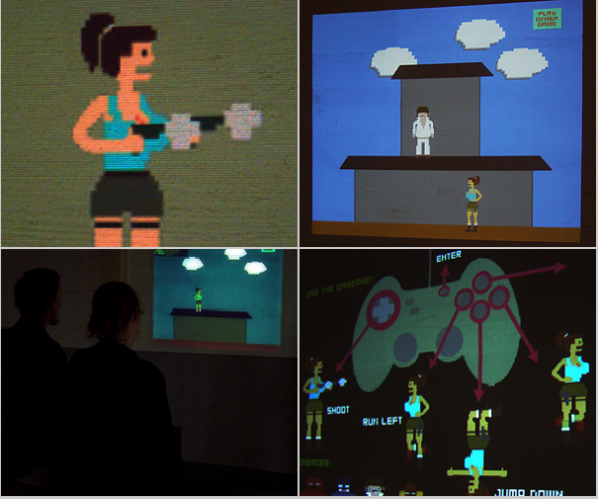
The artists Marieke Verbiesen has created the game Tombraider 0.1 in which she flattened the 3D game into a 2D-world and borrowed aesthetic from the early game consoles. In the new game you could also find references to classic computer gaming experiences such as the stuck “loading” screen, bad language translations and space-invader attacks. It is not unusually that artist create copies of videogames, with 3D hyperrealism graphic, in a retro old-fashioned style.
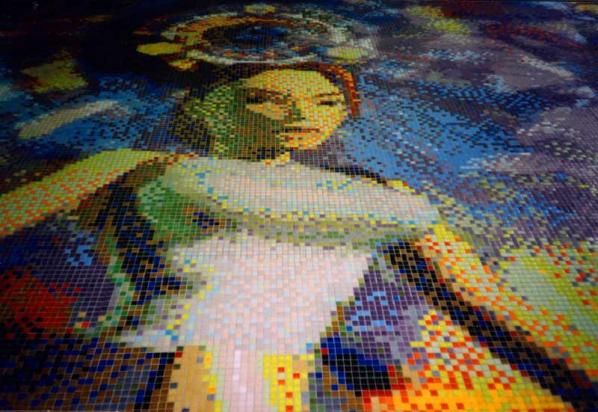
Another way to do this is to use pixel-graphic. That is exactly what Arno Coenen, Rob Coenen and, Rene Bosma did when they re-created he 3D game character into a 2D experience with a touch of pixel-feeling. The project Output: 62.500 materialized pixels, used 62.500 pieces to create a floor mosaic measuring 5,25 x 5,25 meters of the videogame icon Lara Croft. The mosaic has been exhibited at different places in Amsterdam and Kiasma at the Alien Intelligence exhibition in 2000.
So fake polygons or not, it looks like Lara Croft has not only made an impression in the history of videogames but also in the history of art.
Tombraider 0.1 – Single-player game installation based on the famous 3d game Tombraider, starring the female fightingmachine Lara Croft. http://www.marieke.nu/tombraider01/eng/
MUTATION.FEM. Anne-Marie Schleiner “An Underworld Game Patch Router to Female Monsters, Frag Queens and Bobs whose first name is Betty” http://www.opensorcery.net/mutation/
Featured image: Nightingale’s Playground Chapter Selection
Andy Campbell is a UK writer who has been experimenting with new media fiction since the 1990s, when he started creating stories on floppy disc for the Commodore Amiga. By 2000, when I first came across him, he was working mainly in Flash and self-publishing the results on a website called “Digital Fiction”. He has continued to produce one or two pieces of work per year ever since, latterly on a site called “Dreaming Methods”. His output is invariably enigmatic, complex, densely-textured, dark in tone and technically highly-accomplished; and he has gradually established himself, certainly amongst his peers, as one of the leading exponents of the digital fiction form.
His most recent work is also his biggest and most ambitious to date. Entitled Nightingale’s Playground, it consists of four interlinked parts: a click-and-read interactive story; a 3D “game”, which involves exploring a dark flat; a virtual exercise-book, the pages of which can be turned by dragging them across the screen with your mouse; and an ebook text narrative, written in short fragments.
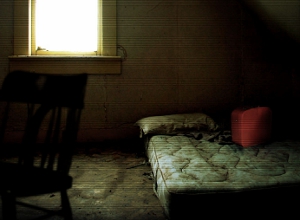
The story, put simply, goes like this. In “Consensus Trance” (the click-and-read interactive section), the adult Carl has just broken up with his girlfriend. The one item he carries away from the breakup is an old red vanity case belonging to his Gran, with whom he used to live when he was a boy. The case contains bits of talismanic bric-a-brac dating back to Carl’s schooldays. Partly because the contents of the case have jogged his memories, Carl attends a school reunion in the hope of catching up with his best schoolfriend, Alex Nightingale. But Alex isn’t there – and furthermore nobody else can remember him. Carl remembers that Alex disappeared unaccountably while he was still at school. He begins to wonder whether Alex actually existed at all, or whether he imagined him; but at the same time he starts to feel as if “ordinary life” might be the illusion, and Alex might have disappeared because he somehow managed to get through to a further reality. He goes back to revisit the flat where Alex used to live.
“Consensus Trance II” picks up from inside the flat’s front door. It takes the form of a 3D “game”, in which we must walk through the passages and rooms of a half-dark flat, discovering fragments of white text as we go, and unlocking extra sections of the flat once a certain number of texts have been discovered. The text-fragments reprise parts of the story which can be found elsewhere, but they also develop the theme that Alex may have disappeared because he managed to get beyond the illusion of everyday life, along with a suggestion that Carl and Alex may be figments of one another’s imagination (many of the text-fragments have Alex’s name in them at one moment and Carl’s at the next), and a third idea that Carl may not be able to remember what happened to Alex because it was something so terrible that he blocked it out of his mind. In the last room of the flat, which has to be unlocked by discovering and “walking through” all the text-fragments elsewhere, this suggestion becomes more concrete: Alex may have tested out his own theories about reality by drinking something poisonous, and therefore he may have disappeared because he killed himself. The process of exploring the half-dark flat thus becomes a metaphor for Carl’s exploration of his own repressed memories, and the fragmentary revelation which awaits us in the last room represents the moment in which he rediscovers his personal nightmare.
The third part of the story, “The Fieldwork Book”, is an old exercise book of Alex’s – or rather a virtual exercise book, apparently recently dug-up, complete with soil-stains, scribbly handwriting, comments in blue from the teacher, doodles, bits of leaf stuck to the pages with sellotape, and woodlice running around on the front cover. It contains the beginnings of a school project about nature – “A dead tree may look lifeless, but actually it’s teeming with activity…” – along with notes from Alex to Carl – “Worthington has paired me up with this mad girl called Joanne. She smokes and stinks but I quite like her.” – and a lot of press cuttings and comments about a computer-game called The Sentinel. All of this makes more sense once the other parts of “Nightingale’s Playground” have been visited, particularly the ebook, which gives a lot of background information about both the Fieldwork Book itself and the Sentinel.
One thing we learn from the ebook section of the story is that The Fieldwork Book is a kind of changeling. Carl buried his science exercise book in the back garden behind his gran’s flat, at Alex’s suggestion, as a way of making it look more grubby and out-of-doors, and thus suggesting to the science teacher that it had been used intensively in the development of the nature project. However, when he dug it up again after Alex’s disappearance, what he discovered was not his own exercise-book but one belonging to Alex.
Another thing we learn is that The Sentinel, to which the Fieldwork Book makes numerous references, is an old Commodore computer-game with which Alex was obsessed. It had 10,000 levels, all based on the same principle: that players had to approach an object called The Sentinel across mountainous terrain without being observed. If they were detected the game would be over. Carl never managed to get very far but Alex managed to get to level 9,999 – and in fact one possible explanation for his disappearance is that it may have had something to do with him reaching level 10,000. He and Carl also played their own outdoor version of The Sentinel, in which Carl would have to stand still while Alex attempted to creep up on him undetected. A copy of The Sentinel is one of the items of bric-a-brac which Carl the adult discovers in his Gran’s old red vanity case.
The ebook also gives some more information about the vanity case itself. When Carl retrieves the Fieldwork Book and finds it to be Alex’s version rather than his own, he hides it in his Gran’s sideboard, and whilst hiding it he discovers something else in there – the red vanity case. The story doesn’t actually tell us in so many words that he looks inside the case, but we gather he must have done, because later on he has a conversation with his Gran, who is telling him that the contents of the case are private and he mustn’t look in there again:
“But what’s that red case? What are those papers?”
“They’re nothing,” she said insistently. “They’re from a long time ago, they don’t make any sense and they’re private love, they’re just private.”
The papers may have something to do with Alex’s death. On the other hand, they may be connected with Carl’s mother, since this is one of the few times in the story when she gets a mention:
…[Gran said] there were things in the world, happenings, that she didn’t understand, and neither would I, and neither would anyone else, and sometimes it was best to just leave them alone.
“Like we leave Mum alone,” I murmured. She didn’t answer that, and looked a little hurt, so I whispered “sorry” and she started talking to me again…
These hints are never developed further.
Nightingale’s Playground is not without its shortcomings. Its most obvious structural weakness is that its four different sections are in four different formats, each with its own distinctive “look” in terms of graphic design, and each needing to be viewed and interacted with in a different way. This is asking a lot of any readers and viewers who are unfamiliar with new media, although it’s actually less of a problem than might be supposed. Once the initial leap of faith has been made the cross-references between the four sections soon start to pull the story together into a surprisingly cohesive single structure. All the same, the fact that two parts are designed to be viewed online, whereas the other two parts are designed to be downloaded onto your own computer (or ereader) does make it a little bit inconvenient to shuttle backwards and forwards between one section and another if you want to examine the story in detail.
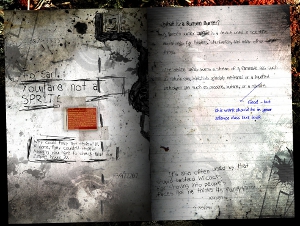
A more serious flaw is the fact that the Fieldwork Book doesn’t actually add very much to our sense of what’s going on. Pretty much all the information it contains (about the Sentinel, and Alex’s view of reality) can be garnered from the other sections, and although reading the Fieldwork Book gives us a slightly stronger sense of Alex’s personality and voice, the material in it begins to seem rather like padding on repeated viewing. There is a similar problem with the red vanity case, which is built up into something of great importance both in the point-and-click narrative section of the story and the ebook. When we actually get to see what’s inside the vanity case, halfway through the point-and-click section, the contents turn out to be rather disappointing.
Campbell does tend to talk up the importance of events and symbolic objects in his stories, rather than leave them to speak for themselves, which can sometimes backfire and lead to a sense of anticlimax. His prose-style can be overblown, a trait which is probably at its most noticeable in the “game” section of the story, where white texts either hang in the air or in some cases appear on the walls of the darkened flat. Some of these texts are particularly sonorous and doomy:
Where were we? Who were we? How much control did we have over the rain coming down, the hideous blank backdrop we were cut and pasted and glued against?
You were onto it, like you were onto something that meant all of this was wrong, some kind of mad illusion; that there was a staggering, amazing psychedelic hope going on that I desperately, weepingly wanted to understand.
I get the feeling everything changed then, like you said words to me that didn’t exist; a language that spoke the impossible; couldn’t be absorbed by the normal brain. Did you even invent some new words? Pierce a new crack in the fabric of what was going on in our limited, messed up world?
“The hideous blank backgrop”; “mad illusion”; “staggering, amazing psychedelic hope”; “desperately, weepingly wanted to understand”; “pierce a new crack in the fabric of what was going on” – the harder these phrases try to impress us, the less they succeed. The trouble is that there isn’t enough concrete observation or information here to convince us that the big emotive adjectives are justified. They seem to be flapping around in a vaccuum.
On the other hand, the ebook section of Nightingale’s Playground contains some of Campbell’s tightest and most effective writing:
Science was my best lesson because Alex was in it – science without Alex was a shitty prospect. I didn’t like any of the other kids in the class, I didn’t like the teacher, I didn’t like doing experiments or doing any work. Science for me was about swapping computer game cassettes under the table, scribbling rude shapes on Alex’s excercise book, whispering about whether the teachers were really aliens trying to brainwash us or whether the entire school was some kind of hologram that folded up and disappeared after the bell for hometime.
This is both convincing about the boredom of being a schoolkid in a dull lesson, and suggestive in terms of the story’s wider themes – the idea that “the entire school was some kind of hologram” clearly links to the alternative-reality theme. The ebook as a whole is written in short punchy sections jumbled into a non-linear sequence, shuttling us backwards and forwards through a term of so or Carl’s school memories, and unfolding (without ever fully explaining) the story of Alex’s disappearance. It works as a stand-alone, but it also works as the glue which holds the entire structure of Nightingale’s Playground together.
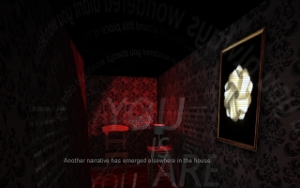
It should also be said that although the flat-exploring section of the story is sometimes overwritten, it is also the most thoroughly immersive of all four parts, and the one where Campbell’s characteristic approach to new media fiction comes into its own most strongly. He has always been at pains not to place his text in front of his images, or beneath them or to one side, like labels on tanks at the zoo or explanatory plaques next to pictures in a gallery; instead he puts his words inside his graphical environments, sometimes hidden or partially-hidden inside them, so that we have to explore to read. This avoids the danger of us regarding the texts as more important than the images. It pulls us in, and it makes his work inherently immersive and interactive.
This characteristic technique is taken a step further in the flat-exploring section of Nightingale’s Playground (which was built with gaming software called Coppercube 2.0), because here the three-dimensional space is deeper, more mazelike and more thoroughly-articulated than Campbell’s customary Flash environments. There is a sinister audio track which changes incrementally as we move from one part of the flat to another, enhancing our sense of three-dimensionality (the audio dimension of Campbell’s environments should not be overlooked in any of his work). The atmosphere is claustrophobic and scary. When you manage to find the right number of texts to unlock an extra section of the flat, there is a loud door-latch click which makes you jump even if you’re expecting it. When you get to the last room of the flat – the one where Carl is starting to get fragmentary recall of Alex’s possible suicide – the space is suddenly bigger, the predominant colour is red, there are items of furniture floating in the middle of the air, the far wall is decorated with a massive staring eye (an icon from the Sentinel game), the text-fragments tend to slide around in front of you as you approach them instead of staying still, and the whole effect is genuinely climactic and nightmarish. There can be no doubt that at moments like this Nightingale’s Playground is an extremely effective piece of new meda fiction.
It’s interesting to note how closely the climax of this flat-exploring sequence resembles Grandma’s house in Tale of Tales’ horror-game The Path. Campbell is an admirer of Tale of Tales’ work, but he hadn’t seen The Path prior to the completion of Nightingale’s Playground. All the same, the parallels are striking: the feeling of combined claustrophobia and disorientation, the sinister red-and-black colouring, the way the reader/viewer is barraged with suggestive fragments, and the way this technique is used to suggest flashbacks. There is a strong sexual theme in The Path which is not present in Nightingale’s Playground, but otherwise it’s difficult to escape the feeling that both Campbell and Tale of Tales have seized upon the exploration of a mazelike game-space as a metaphor for an inner journey, and have developed the metaphor in very similar ways.
Readers who are familiar with Campbell’s earlier work will recognise a number of the themes and motifs employed in Nightingale’s Playground. The Fieldwork Book, for example, is designed in very much the same way as an earlier virtual exercise book from a story called “The Scrapbook”; collections of fragmentary jottings, or old half-corrupted electronic files, can also be found in “Fractured”, “Floppy” and “The Incomplete”; the feverish boy being looked after by his Gran, with his mother either absent or not interested, is a familiar figure from “Dim O’Gauble”; the schoolfriend who introduces the first-person narrator to an apocalyptic secret is an echo of “Capped”; and a gloomy flat which must be explored for clues to the story’s central mystery can also be found in “The Flat”.
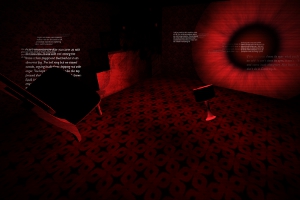
But these narrative strategies in turn suggest certain deeper patterns on which much of Campbell’s work seems to be built. His abiding interest in hints and fragments, for example, is admittedly suited to the nonlinear style of new media literature, but it also serves to suggest that Campbell’s central characters are often living in a reality with two layers: the “ordinary” everyday world which is mean, dull, shoddy and constricting, but relatively safe; and an inner or underlying reality which can only be glimpsed rather than viewed as a whole, possibly because it is so dangerous and frightening – a reality which emerges fitfully via dreams, games, imaginings and doodles.
It also frequently the case in Campbell’s work that the constricted dullness of the “ordinary” world is associated with adult life and adult sensibilities, whereas the “inner” reality is associated with childhood. Thus, in Nightingale’s Playground, the adult narrator starts to rediscover his “real” self when he breaks up with his girlfriend and rediscovers his memories of his best friend Alex. In a way, this could be seen as a Romantic or Wordsworthian view of the relationship between childhood and adulthood: as children we are much more in touch both with our imaginations and our inner selves, and therefore much more aware of the true nature of things, while as adults we become more absorbed in “getting and spending”, and therefore spiritually dull. Campbell is certainly no sentimentalist about childhood – in fact his stories are full of instances of kids being nasty to each other – and it should also be noted that the imaginative insights of the children in his stories may be shared or partially shared by more elderly figures such as the Gran in Nightingale’s Playground, another Gran in Dim O’Gauble, and the dying old man in Last Dream. It may be that these old people share the visionary capabilities of the young by virtue of their closeness to death – there are strong hints in the ebook section of Nightingale’s Playground that Carl’s Nan is about to die of lung cancer.
Perhaps a better literary antecedent for Cambell’s obsessive and visionary kids is the figure of Roland from Alan Garner’s Elidor – another hypersensitive and super-visionary outsider whose insight and talents serve to isolate him both from the mundane world of the Manchester suburb where he lives, and from the other members of his own family who would rather have safe, dull lives than dangerous, eccentric and magical ones. Of course Roland is an outsider-figure who can easily be identified with Alan Garner himself; and in the same way, Alex Nightingale can easily be identified with Campbell. The refusal of these visionary characters to settle for mere ordinary life can be interpreted as an oblique declaration of intent from the artists who created them. But there are other messages here too. The whole structure of Nightingale’s Playground is telling us something about the nature of the world we live in. Did Alex Nightingale actually disappear into an alternative reality, or did he commit suicide? Did Carl imagine Alex, did Alex imagine Carl, or did they both somehow imagine each other? Is the Sentinel just a computer-game or the key to something deeper? What was in the red vanity case when Carl first discovered it? What is the secret his Gran is so anxious to keep hidden? The fact that all of these issues are left hanging, and that the whole pattern of the story is therefore deliberately-unresolved, ambiguous, is a message in itself. Life isn’t clear-cut: it isn’t about answers: it’s about questions.
Nightingale’s Playground has its shortcomings, but it builds Campbell’s open-ended style of narrative into a more ambitious and absorbing structure – and explores some of his characteristic themes with greater maturity and depth – than anything he has produced before.
This review is co-published by The Hyperliterature Exchange and Furtherfield.org.
Featured image: Landscape by Antoinette J. Citizen (2008-2010)
The Italian plumber Mario appeared for the first time in 1981 as a character in the videogame Donkey Kong, created by the famous Japanese game developer Shigeru Miyamoto. Two years later, Mario became the main character of his own game, and his fame grew exponentially. Approximately 200 different videogames have been produced where Mario has the lead role. In contemporary art Mario is also a popular personality and Cory Arcangel is the artist who has done the most famous works based on the videogame.
Super Mario Cloud is probably the most famous of Archangels’ Mario works. It was created in 2002 and was exhibited at the Whitney Biennial 2004. In Super Mario Cloud Arcangel has hacked and changed an old Nintenedo game cartridge so that the only thing that remains of the original game are the little white fluffy clouds that slowly scrolls by on the clear blue sky. Since Arcangel has taken away all of the game elements and interaction you can refer to it as an anti-game. You can also interpret the work as a renewal and a commentary on the art historical genre cloud painting that became popular during the 1800s, when the science of cloud formations and their appearance emerged.
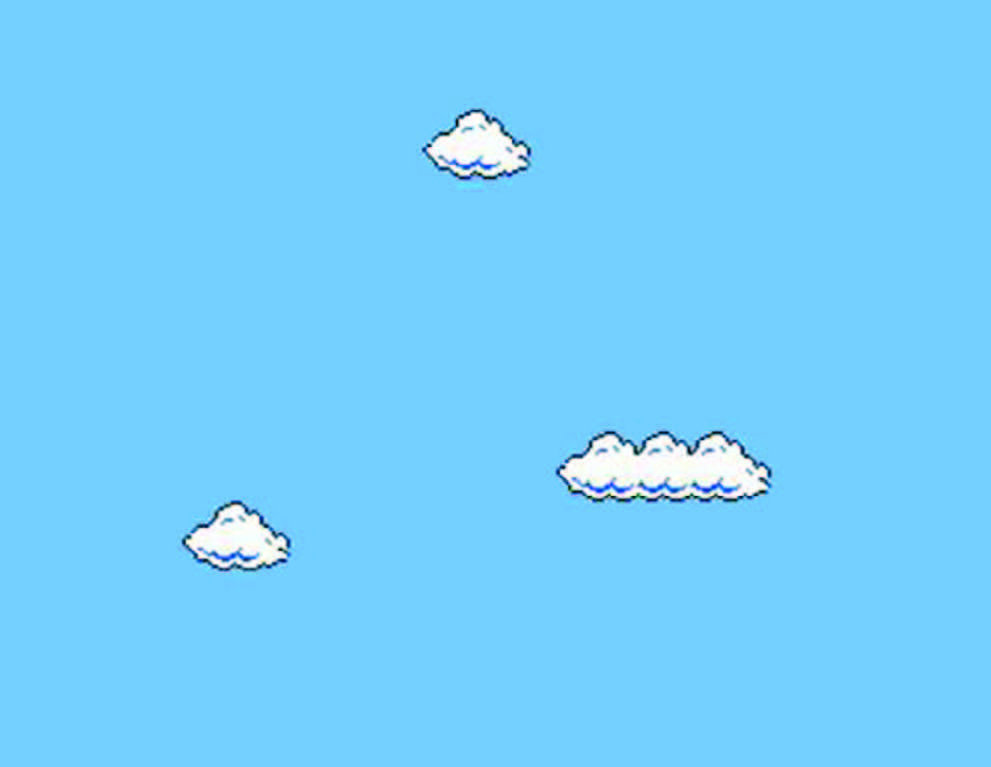
Super Mario Movie is a 15 minute video which Arcangel did together with Paper Rad in 2005. Again, this is a hacked cartridge of a Nintendo, and in the opening scene, you can read the following text:
“As a video game grows old its content and internal logic deteriorate. For a character caught in this breakdown problems affect every area of life.”
For Mario, it means that when his world grows older its graphic content and logic breaks down until he finds himself trapped in a nightmare where he falls head over heels down the screen in a changing fragmented world of psychedelic colours in which, among other things, a giant Mario head pops up. What Arcangel describes is the natural degradation process that eventually affects all physical storage devices from floppy disks, CDs to hard drives. When the stored information is getting corrupt by age it results in misreading with strange and illogical effects on the screen. It’s not just we human that are having problems when our cells and DNA are getting corrupt by age, even game characters could experience strange behaviors and diseases when their data ages.
Video: Naptime by Cori Arcangel (2002)
In the video Naptime (2002) we find Mario sleeping in his bed and above him is a dream cloud that consist of a psychedelic stream of characters and colours – the same effect which you can experience when you try to run old games that have become damaged or are using a computer with a broken graphic card. Just like in Super Mario Movie it seems like a nightmare is chasing Mario in Naptime. It is a world of corrupt code and information in which the game logic has broken down, a world that behaves as if it was infected by a nasty computer virus.
Video: SuperMario Sleeping by Miltos Manetas (1987)
The artist Miltos Manetas has also created a video with a sleeping Mario. In the three-minute long film Super Mario Sleeping (1987) we see how Mario gets tired and lies down and sleeps in the grass. Just as in Arcangel artwork the video is describing an anti-game. All the interactivity and stress in the game are removed and instead we experience a calm and meditative atmosphere. Philip K. Dick novel Do Androids Dream of Electric Sheep? (1968) comes to my mind. What is it that distinguishes a human from an android or a character in a video game? Can characters in computer games dream and, in that case, what are they dreaming of when we are not playing them?
It is now not only the character Mario who is interesting for artists, but also the objects in the game. The Australian artist Antoinette J. Citizen created in 2008 the interactive installation Super Mario Brothers Level 1-1 in which she transformed an art gallery into a Super Mario game. She painted the walls with different levels of the game and installed interactive boxes with question marks and bricks. The visitor could touched the boxes which then produced different sounds from the game. Citizen’s works are, like many other Game Art works, an example of how artists transfer the virtual game world into the real exhibition space.
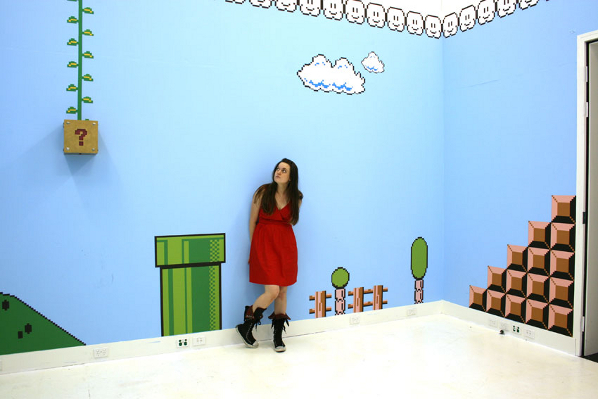
Mario is probably the most famous character in the videogame world. The question is if he is not as famous as Jesus? The Polish artist Kordian Lewandowski plays with the idea in the work Game Over. He has created a copy of Michelangelo’s famous Pieta sculpture but instead of a dying Christ in the arms of the Virgin Mary, we see Mario lying lifeless in the arms of Princess Peach. It seems that videogames with their own iconology and stories about the constant struggle between good and evil, in some degree, have taken over the role of religion when it comes to creating references and cultural contexts for people.
http://www.coryarcangel.com/things-i-made/supermarioclouds/
http://www.coryarcangel.com/things-i-made/supermariomovie/
http://www.artforum.com/video/mode=large&id=25370
http://www.supermariosleeping.com/
http://antoinettejcitizen.com/works/landscape/
http://wielkiartysta.pl/content/index.html
The four day event at the Showroom collated a series of practitioners, artists, theorists and historians, to examine, test and explore ideas stemming from cybernetics and information theory and more specifically the idea of feedback.
Described as an ‘experimental cross-disciplinary research project’, Signal : Noise was a fusion of talks, lectures, performances, screenings and debates that made diverse contemporary evaluations of the legacy of cybernetics using an inter-disciplinary approach. It tackled subjects as seemingly diverse as economic theory; urbanism and the arrival of the motor car in London; game theory; linguistics; media-performance art from the 1970’s; and the problematic legacies of the recent UK arts funding system on artists – all viewed using the concepts and terminologies of cybernetics and systems.
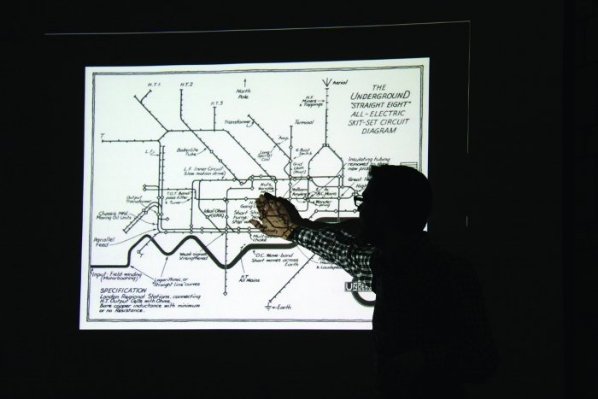
Signal : Noise, in part, played out like a small conference, mainly set in The Showroom Gallery space with one wall covered with a network diagram drawing by Stephen Willats, and fly posted theoretical systems diagrams from his recently re-published 1973 book, or maybe manual, ‘The Artist as Instigator of Changes in Social Cognition and Behaviour’.
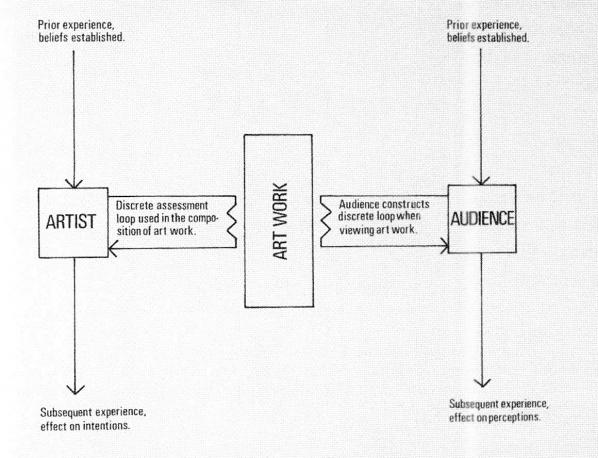
This visual reference served as a backdrop to the proceedings and served as an on going reminder that despite the deep theoretical and historical base being presented and discussed in its many forms, Signal : Noise was ultimately attempting to re ignite debates, and help reset the ideas of cybernetics and systems into a contemporary context of practical application. Willats’ book describes his process as an ‘investigation by the artist into the processes, procedures and models’ of the ‘Art Environment’ using ‘cybernetics as a research tool’.
The first night introductory presentations by Charlie Gere and Steve Rushton provided an overview of many ideas explored throughout the weekend. Artist and writer Steve Rushton on ‘How Media Masters Reality’ used an array of examples, from conceptual and media architecture group Ant Farm using pioneering ideas of investigating media feedback, through to the 500 millions votes (!) on US TV programme American Idol; the latter an example of how contemporary applications of media feedback loops are now often conceptually embedded into the core of television productions, and in turn, are now part of the audiences expectations and involvement.
Ant Farm’s 1975 work ‘The Eternal Frame’, screened later during the weekend, along with Gary Hill’s Why Do Things Always Get in a Muddle (Come on Petunia), based on Gregory Bateson’s Metalogues.
Ant Farm’s 1975 work ‘The Eternal Frame’, screened later during the weekend, was their carefully staged, somewhat trashy live ‘re enactment’ of the 8mm film footage of the Kennedy assassination, complete with a drag version of Jackie Kennedy and sunglass wearing suited security. This film sequence is familiar today, but in 1975 it had yet to reach the public domain. Working to a tightly choreographed moment derived from a bootleg of the 29 seconds of 8mm film, Ant Farm’s grotesque mimicry of the assassination was performed as an ongoing loop, complete with car driving around the block (interestingly, the random people watching in the street in 1975 took photographs like they were at a theme park).
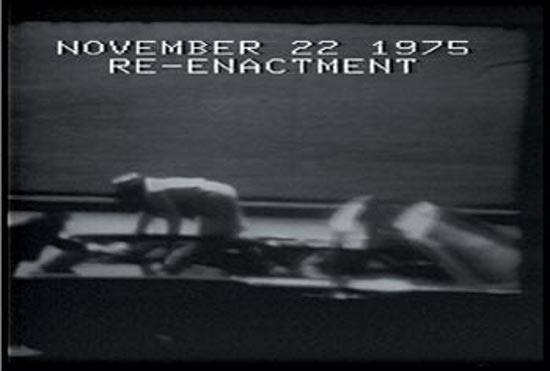

Despite being conceived in the mid ‘70s media environment of portable video and cassettes, the documentation of Ant Farm’s performance resonated with something surprisingly familiar and contemporary in our era of the internet, social media and rolling 24 hour news, and what Rushton termed our “society of self performance”.
Rushton’s historical threads from the origins of Cybernetics and to the Whole Earth Catalogue and the WELL served as a excellent base for the oncoming proceedings of the weekend, and showed that the arrival of the contemporary mass information network in the form of the internet, has habituated it’s millions of users into a kind of cybernetic practice based on input, observation, control, intervention, response, feedback, and adaptation but without necessarily using or being aware of its lexicon.
Nearby, in the Cockpit Theatre, was ‘Closed Circuit’ a performative work by Rod Dickinson (along with Rushton), which consisted of two actors staged and dressed, in a precise duplication of a set for political announcements; wooden lecterns, curtained background, complete with an array of flags – but all carefully neutralized by the removal of logos and national flags identities into plain white.
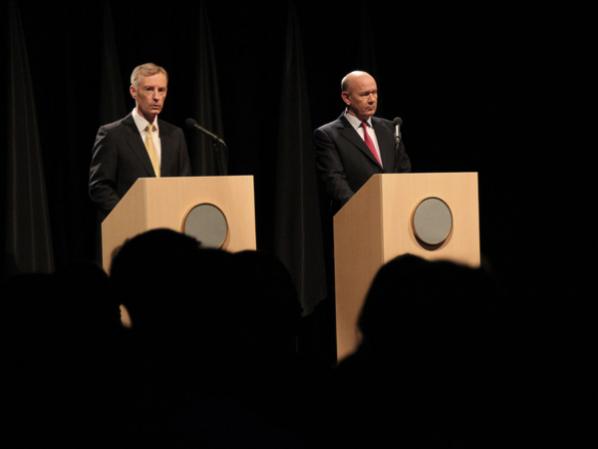
What followed was a series of political speeches utilizing the familiar language and tone of grandeur and crisis, delivered by the actors in the style of a world leader address. What they delivered, was a carefully sequenced remixed script derived from political speeches over the past 50 years; Margaret Thatcher; Richard Nixon; Ronald Reagan; Tony Blair; Yasser Arafat and others. All the details from each specific event they were referring to had been carefully edited out. The only way to differentiate one world leader, country or event from another, were the large projected auto cues for the actors, situated behind the audience at the rear of the theatre. Each one gave the full scrolling speech text and also the year and original context for each leaders’ delivery. Looking towards the stage, it sounded like a single coherent speech, but eluding any specific meaning, isolating the language of threat and authoritarian political control, leaving us just the husk of political presentation and the transparency of the format itself.
Ideas explored in Stephen Willats’ network drawing were expanded further during his talk in the final morning session of Signal : Noise, where he gave a refreshing clarion call to abandon ‘last century thinking’ during his prescient and timely discussion. His seminal works have persistently and methodically challenged the process, structure and meaning of art making and display. Willats made his earliest system diagrams in the late 1950’s, and was the first artist to make the artwork itself a map of communication. But maybe it is this century, rather than our last, that will connect with his provocations to the hierarchical, highly codified, object obsessed ‘Art Environment’, as he terms it, to see that ‘object based thinking is still a hangover from last century attitudes’.
Willats was an early reference for emerging net art and media art in the mid 90’s, with artists then clutching for any art historical roots that gave the field of networked and computer based practice some practical grounding.
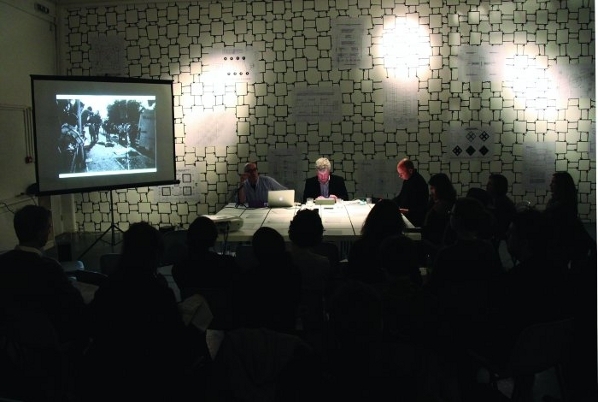
This in-conversation with Emily Pethick surveyed his own personal development and immersion in Cybernetics in its differing stages, a short history lesson, moving from Norbert Weiner to Gregory Bateson and Gordon Pask, but always resolutely en route to the practical issues in the present and what Willats defines as the artist as an ‘instigator of transformation’.
In parallel to Willats, was a presentation and discussion hosted by Emma Smith and Sophie Hope which began to interrogate the legacy of a the New Labour arts commissioning process. It discussed how the criteria for successful funding was intrinsically linked to a social agenda, audience and location set by government policy. Discussions followed about how the arts commissioning process may turn out to have skewed a generation of artists practice, as they slowly lost control of their own output, became tagged with being an ‘artist facilitator’, and began conceiving works to fit in with the criteria of funding bodies, with each funder slowly extending their own prospective reaches. All this supported by an immense drive to build ‘Cultural Industries’ into mechanisms for regeneration.
Seeing this placed against Willats, whose ongoing practice could initially seem in tune with the past decades cultural policies and its overtly prescribed socially engaged agenda, in fact served to show how contrasting, distinct and rich his rigourous thoughtful approach is by comparison.
All this made for a timely discussion. With the approaching withdrawal and decimation of arts funding in the UK, Signal : Noise could prove to be a prescient event. With presentations, workshops and panels by Stuart Bailey and David Reinfurt of Dexter Sinister, Charlie Gere, Matthew Fuller, Marina Vishmidt and others, the interdisciplinary approach of Signal : Noise worked well despite its fairly dense timetable.
Using the gallery as a discursive space, with theorists and writers set within context of practice, is a good base for the next event in this on going series. What it maybe didn’t allow for, which is easily rectified, is a more unpredictable agenda, and more intervention by the ‘audience’. The whole event could function more as a real feedback working system, an adaptable structure that potentially allows for input from its participants (both presenters and audience) letting things move in unexpected directions both on line and offline, leaving a physicalised network as a residue after the event. With the decision to include food and beer in the ticket price (great dumplings, fresh vegetables and miso soup), there is potential here to expand this type of event even further.
With the on coming cultural landscape in the UK moving into un-chartered territory, it is potentially events like Signal : Noise which might begin to unearth and test new ideas and ignite debate within a less rigid format than a ‘curated’ show. In the future this type of event may even re-claim the word ‘radicalise’ from its current narrow, negative media usage, and re-purpose it for artists who decide to reject art market values, in favour of a exploring new ways of working within the emerging (and significantly less funded) ‘Art Environment’.
Signal : Noise. The project was led by Steve Rushton, Dexter Sinister (David Reinfurt and Stuart Bailey), Marina Vishmidt, Rod Dickinson and Emily Pethick. http://www.theshowroom.org/research.html?id=161&mi=254
The Artist as an Instigator of Changes in Social Cognition and Behaviour. 1973. Stephen Willats. http://www.occasionalpapers.org/?page_id=825
Closed Circuit, Rod Dickinson in collaboration with Steve Rushton.
http://www.roddickinson.net/pages/closedcircuit/project-synopsis.php
Dr Charlie Gere. Reader in New Media Research. Department: Lancaster Institute for the Contemporary Arts. http://www.lancs.ac.uk/fass/faculty/profiles/charlie-gere
ANT FARM. ART/ARCHTECTURE/MEDIA [1968-1978]. http://artsites.ucsc.edu/faculty/lord/AntFarm.html
The Eternal Frame by T.R. Uthco and Ant Farm: Doug Hall, Chip Lord, Doug Michels, Jody Procter. 1975, 23:50 min, b&w and color, sound. http://arttorrents.blogspot.com/2008/02/ant-farm-eternal-frame-1976.html
Emma Smith. Social practice that is both research and production based and responds to site-specific issues. http://www.emma-smith.com/www.emma-smith.com/Homeindex.ext.html
Sophie Hope’s work inspects the uncertain relationships between art and society. http://www.welcomebb.org.uk/aboutSophie.html
20 Digital Years Plus
Station Rose
Nurnberg 2010
ISBN 9783869841113
“Twenty Digital Years Plus” is a softback book that presents and contextualises the art of Station Rose (Elisa Rose and Gary Danner) from 1988 to the present. Its gatefold cover conceals both a CD and a DVD which provide audio and video to complement the static images and texts, and carries an endorsement from Bruce Sterling on the back cover.
The book starts with a series of essays before presenting an illustrated history of Station Rose. Those essays approach Station Rose from some refreshing and unexpected angles to make a convincing claim for their art historical interest.
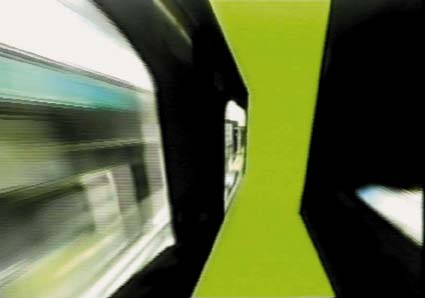
Peter Noever writes in the book’s preface that “Media art is both an art form and a way of life for Station Rose”, a claim that the evidence of the book more than supports and that I think is key to why Station Rose’s art is so interesting. The book functions as a mid-career retrospective, and Noever suitably sets the themes of achievement and continuity.
Vitus H. Weh’s essay explains how Station Rose got their name and puts their LoginCabin project into the context of German post-cold-war architecture and the sociology of the Wild West. We are a long way from the early 90s view of the Internet as a new frontier, but despite its critics that view was not uniquely tied to American society and provided a liberating impetus to individuals who didn’t always subscribe to the Californian Ideology.
Hans Diebner’s critique of net art and activism brings a thought-provoking scientific, techno-art historical and philosophical critical literacy to bear on Station Rose and the artists and activists that he contrasts them with. Diebner weaves together diverse conceptual strands into a coherent critical case without any resort to jargon, and it’s worth thinking through how his case affects our view of net art in general as well as Station Rose’s position within its history.
Didi Neidhart’s interview with Rose and Danner provides context for and insights into how the pair create and conceptualise their work, and how their art and music relate. Station Rose emerge as the product of cultural engagement and lived history rather than academic fashion.
Gabriel Horn writes from a curator’s point of view about the future shock of working with Station Rose in 1991, in contrast to working with them in 1999 when they are part of an intermedia exhibition.
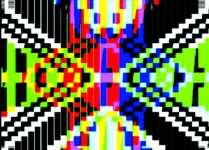
The bulk of the book is an illustrated history of Station Rose. They started out in 1988 as a multimedia lab in Vienna complete with 16-bit Amiga computer. In November 1988 they went online for the first time at the Sampling conference they held in Vienna, having already adopted the technology and concepts of sampling into their art and performance. Since then their work has taken the form of CD-ROMs, live streaming media, live multimedia performance, Internet homepages, CDs and vinyl with Sony records, books, TV shows, multimedia installation, webcasting, lecturing, teaching, and a shed.
Station Rose also create memes, or language, such as the statement quoted by Bruce Sterling on the back cover that “Cyberspace is Our Land”, the much needed identification of the “Digital Bohemian Lifestyle” and the increasingly paradigmatic condition of being “private://public”. Even in an age when the concept of multimedia has largely been absorbed by the Internet their work crosses and assembles different media.
Much of Station Rose’s digital art has the not quite glitch aesthetic of overlayed pixellated form in shallow depth that any serious history of digital art needs to account for. But the cubicles, huts, pillows and panels of their installation work have the same aesthetic. Station Rose’s work is in itself a history of digital art over the last two decades. And this digital art is always in dialogue with physical performance and physical structures, the virtual in dialog with the real to illuminate each other.
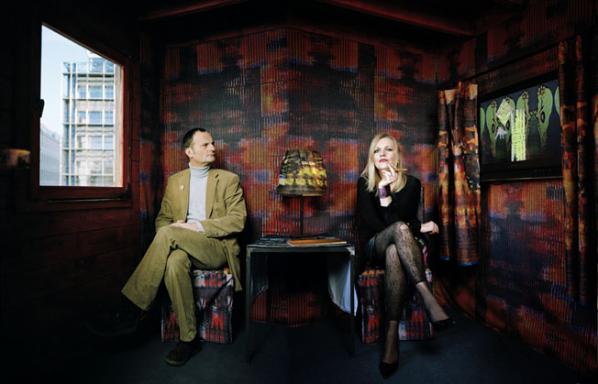
In Neidhardt’s interview, Danner says of Station Rose that “We are quickly bored with things as soon as they become mainstream.” Boredom with the content and products of digital media is the friend of the scheduled obsolescence and cultural amnesia of market mass media. But boredom with the form of and the means of creating digital media can also serve to motivate the creation of successive alternatives to it.
Over the last 20 years the Internet and digital media have gone from being a novelty to being socially and economically pervasive. This rate of change, and the constant promotion of different visions of what the Internet is for by different institutions, mean that our relationship with the Internet has come to be in plain sight. Artists can usefully depict and help us conceptualise that relationship, particularly those artists who can use the digital media that has been drawn into the Internet and become no small part of its operation.
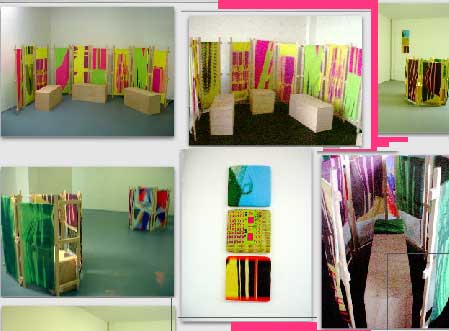
Station Rose are such artists. Their art has the quality of being both the product and producer of lived experience in the age of digital media. It refracts the logistics and glitches of the Internet through the prism of contemporary art’s deceptively low-fi rummage sale aesthetics to present them as objects of contemplation. When digital media was new this served to make them accessible to an unfamiliar public. Now that digital media are pervasive to the point of invisibility, this serves to make them visible again as objects of contemplation and to afford the viewer a critical distance from them.
20 Digital Years Plus is an engrossing, thought-provoking presentation of the ongoing development of Station Rose that makes clear the value of their constantly enquiring relationship to ever changing technology.
(With thanks to @MarkRHancock)
The text of this review is licenced under the Creative Commons BY-SA 3.0 Licence.
Featured image: Games/03 Paul Sermon, Peace Games, © der Künstler 2008.
Das Spiel und Seine Grenzen: Passagen des Spiels II ed. Mathias Fuchs and Ernst Strouhal, (Springer Verlag, 2010), German language only.
Fuchs, Mathias; Strouhal, Ernst (Hrsg.)
1st Edition., 2010, 272 S. 16 Abb., Softcover
ISBN: 978-3-7091-0084-4
Versandfertig innerhalb von 3 Tagen
Mathias Fuchs is considered to be one of the first artists to explore the combination of videogames and art. Today he is a senior lecture at Salford University in England and a leading researcher on Game Art and ludic interfaces. Social and political context in videogames and how they affect our society has been a major topic in Fuch’s research. Last year he published, together with Ernst Strouhal, an anthology of videogames and its borders and how this genre is changing and influencing society. The background to the anthology was an exhibition held at Kunsthalle Wien in 2008 about art and politics in videogames.

It has been 60 years since Johan Huizinga’s now classic book Homo Ludens, the playing human, was published. Games are no longer just entertainment; it’s a major industry that is affecting our society in every aspect. In the foreword Fuchs states that the main issue for the 15 essays in the anthology is how games have changed and affected our society both politically and socially since they crossed over from the realms of entertainment into everyday experience.
Today we can find many different genres in videogames, such as serious games and persuasive games, that discuss current issues, news and social problems, artistic games which address existential and aesthetic aspects, and so on. The gaming community has grown enormously and created on-line worlds with strong virtual economics, attached real world economics. In her essay Daphne Dragona says “The virtual environments of our times therefore can be seen as social institutions with social, political and economic values resembling those of real life.”
In a similar way Tapio Mäkelä’s essay about locative games describes how the gamescene has entered the real world in the form of cos-players and social gameplays where videogames as Pacman are performed in the city streets or games as “/Noderunner/, where participants run to find open WiFi Networks, take a photo of themselves at the location and send the info via e-mail to the project’s website.” This begins to close the gap between networks and everyday experience through the practice of social gaming. The game as object is less of an obvious conclusion now that technology enables us to explore ourselves within networked, gaming contexts and mobile technologies.
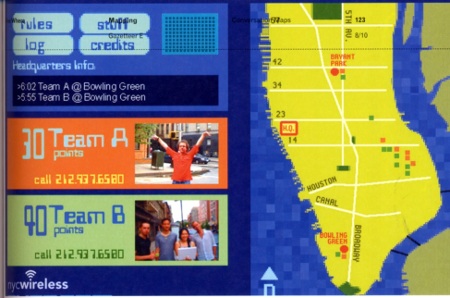
The borders between game and reality have now become even more blurred and integrated, especially if we consider how technology itself also crosses over into administrational activites which have already been traditional elements of controlling, processing parts of our lives. One example is how authorities around the world are supervising these new socio-economics, such as collecting taxes from virtual incomes by using similar tools and networks. There are many questions about how games will continue to affect and change our society in the future and the anthology takes an interesting and comprehensive look into what games have to offer and what could be potential threats to our future societies.
Today games are serious business. It is not impossible that in the future a bankruptcy of an on-line gameworld could shake the real world and create an economic depression. On the other hand, could on-line game economies bring prosperity and create new jobs, an economic boom in ways we have not witnessed before? If games move into a new period of changing social experience in even more connected ways than before, then we need to understand what the consequences of these are and how to navigate through this shifting terrain. One thing is for sure, it was a long time ago that games were just entertainment.
http://www.springer.com/new+%26+forthcoming+titles+%28default%29/book/978-3-7091-0084-4
Brian Eno hovered over me in a darkened room as I squatted writing notes about his 77 Million Paintings on a crumpled up piece of paper. Though I knew he couldn’t see what I was scribbling, its not often one gets the chance to come face-to-face, or rather back-to-face in situ with the flesh and blood incarnation of one’s investigations. He had slipped into the viewing room at the Glenbow Museum unobtrusively because he likes to watch – the audience as well as his “paintings,” and therein lays his strategy and appeal. In a lecture he gave that night at the Museum auditorium he described, in magnificent pantomime, the reactions one has when entering the viewing space of his exhibit:
looking around, furtively glancing at the work
walking further into the space, looking around, glancing at the work
leaning against the wall, glancing at the work
squatting, glancing at the work
sitting down, glancing at the work
focusing on the work, lying down on the floor mesmerized by the work
unable to tear oneself away from the work
77 Million Paintings contains 550 paintings Eno created over a span of 22 years. Since 2006 the exhibit has toured all over the world including Tokyo, Sydney and St. Petersburg before landing in Calgary. The digital projection is a “generative” work in that the ambient music for which Eno is better known, and the combination of images are generated and combined in an endless mandala-like array by a computer. Nine screens project a diamond shape with eight inserted “paintings” and one solid colored square on the lower right hand side serves as a control for the other eight. There are four black leather couches for people to zone out on while enveloped by his signature ambient sounds – and they are packed to capacity as the audience warms and hunkers down to the slow experience.
Originally conceived for in-home viewing, the show seems to change your brain waves from Alpha to Beta to Theta and the experience is pure occipital enjoyment. The cross-fades in the banks of images creep up as the landscape subtly changes as blue morphs into green, and triangles expand into circles As Eno says, “We’re not seeing a film. There’s no beginning, there’s no progression, there’s no end, there’s no narrative, there’s no drama. In fact everything is missing that would normally be called art or entertainment.”
Eno’s lecture at the Glenbow Auditorium could have continued all night but for the protestations of those with day jobs. He began explaining the radical impact Copernicus had in 1543 when he revealed man was no longer the center of the universe, as earth orbited around a system with some 400 million stars. Darwin came along in 1859, and pointed to the phylogenic tree stating there were 20 billion species besides humans. “ We are amazingly minute in this picture,” Eno mused. After Darwin it was Cybernetics, which introduced the notion of feedback as a way to think about complex systems. We cannot control these systems, only set them up to control themselves, and that notion became part of his vocabulary of how things organize themselves.
Starting with royal Kings and the Church, man organized himself in hierarchies from the top down that includes the structure of the 18th Century orchestra, still extant today. Sixty or seventy years ago this would show up in the shape of a top-down pyramid, but the world now functions more as a feedback loop, not a hierarchy. Eno explained when he was growing up his uncle slipped him a book on the artist Mondrian. He found the pictures magical, economical, and transparent. They contained “no subterfuge of technique.” Attending art school at Winchester School of Art, part of a music school in England, his forward thinking art professors invited the composers John Cage, Christian Wolf and Morton Feldman to lecture. Not one musician or music student on campus came to hear them.
He described listening to Terry Riley’s minimalist music composition In C,as “life changing.” That piece contains 53 short, numbered musical phrases lasting from half a beat to 32 beats repeated an arbitrary number of times. He also mentioned Steve Reich’s It’s Gonna Rain, where Reich recorded Brother William, a Pentecostal preacher and “sought to maintain the fascination of the speech content while intensifying its meaning and melody through rhythm.” This piece Eno admitted, “is the basis of most of my career.” He said one’s ears function differently than one’s eyes. Eyes scan all the time. If they don’t scan, they habituate and don’t see any thing. If you have a repetitive event the eyes cease to see, and what he focuses on is the uncommon information, “the out of phase collision of the loops.” This approach makes your brain do the composing. As this he says, has led him to his work ethos, “doing as much as I can with as little as possible.”
—-
Brian Eno’s exhibition 77 Million Paintings takes place in the Glenbow Museum from January 6 to March 20 2011. http://www.glenbow.org/exhibitions/
A performance by Alexandre Burton and Julien Roy
Alberta College of Art and Design (ACAD), Calgary, Canada, November 11, 2010
“We are absorbed by the beauty of electronics absorbing into the air,” is how Burton and Roy described their literally electrifying, and often frightening forty-five minute audiovisual performance of high-voltage electromagnetic disturbances. The event necessitated everyone present turning off their cell phones, i-whatever’s, and cameras to avoid provoking 800,000 volts of raw Frankenstein-like crackling electricity from throwing out a surprise lightening bolt and zapping an unsuspecting audience member.
POWEr’s instrument is an audio-modulated Tesla Coil with its own “boutique” ground that resembles a stripped down tuba with lots of copper colored coils. A bent over piece of metal culls the tail end of the generated electricity so it can be captured by a high-speed camera, and processed and re-purposed. Both Burton and Roy, who trained in contemporary classical music training in composition and electro-acoustics at the University of Montreal added, “We like noise so we try not to do melody, except at the end.”
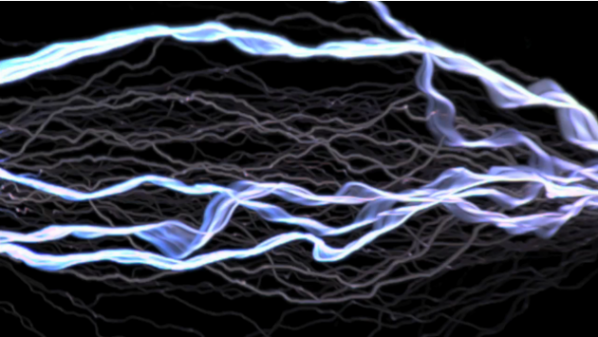
The piece is raw and alive, and no photograph or video can substitute for sitting in the line of fire of a sparking raw electrical feed. It smells tangy and metallic; a by-product of its ozone inducing properties and you can practically taste the microscopic particulate matter its hybrid frisson generates on your tongue. The sheer shock of its taser-like impact up close and personal is mesmerizing and anesthetizing but its actual menace doesn’t lie in its extreme voltage, but in its electrical amps, which is the charge that actually goes through you. “If the amp is low it just goes onto your skin, but if the amp is high you can die,” the artists sanguinely informed the audience in a Q & A after the performance. They also explained it took six months to come up with the idea, and another six months to make he piece not explode.
The creator’s studio site Artificiel.org says they are interested in “the desubjectification of sound and image materials, R&D creativity as the consequence of artistic research and the building of a genuine digital performance practice.” This idea is coupled with an astute technical know-how. To capture such an electrifying event the camera runs in a special “forever mode” that can be wiped clean at their discretion. The electromagnetic arc produced by the Tesla coils lasts for just a few very bright nanoseconds, so using a mechanical shutter is impractical. The ISO, dampened down to 50, allows a baseline sensitivity to actually capture the image.

Once captured, the images are transferred to the computer via a high-speed uncompressed connection, where recording, filtering and geometric adjustments are made. The visual data is handled as sound, allowing quick and precise images to be processed on the fly. “It is also a very intuitive approach to “synesthesia,” Burton said as the software abstracts both sound and visuals in the same way. Logic Pro and MAX/MSP/Jitter manipulate duration, signal, timbre, and resonance live time as technology and geekiness combine with a dash of old style showbiz razzle dazzle to produce a truly hair raising show.
(Images above are excerpts from a performance in Québec city 2010)
View video of Alexandre Burton’s and Julien Roy’s live performance here http://vimeo.com/9816953
Form+Code In Design, Art and Architecture
Casey Reas, Chandler McWilliams, LUST
2010, Princeton Architectural Press
ISBN 9781568989372
Form+Code is an art computing programming primer. Rather than teaching any particular programming language it explains the technical and conceptual history of programming and its use in art. Starting with an introduction to the basic concepts of coding, instructions, form, and different ways of representing them (in sections titled “What Is Code?” and “Form And Computers”), it moves on to chapters covering “Repeat”, “Transform”, “Paramaterize”, “Visualize” and “Simulate”.
The basic concepts of programming are explained clearly with plenty of examples of code, hardware, and output. They are also related to broader art history, with examples drawn from conceptual artists such as Yoko Ono and Sol leWitt. And it’s good to see Jasia Reichardt’s pioneering work in bringing art and code together is recognised not just in the form of the Cybernetic Serendipity show at the ICA in London but her books and articles on art computing as well.
There is a little code, enough to give a flavour of what it looks like but not enough to intimidate. Listings in or examples of output from BASIC, LOGO, BEFLIX, Hypertalk and other important historical programming languages are presented. PostScript is given its due, with listings, examples of output and a discussion of its incredible impact on the graphic design industry.
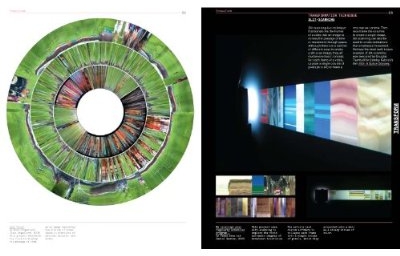
Form+Code is about hardware as well as software. The Difference Engine, ENIAC, oscillioscpes, the PDP-1, arcade games machines that used vector graphics, and the Atari 2600 are all included in a historical narrative of computing and art. The book also describes and shows examples of output from printing hardware from pen plotters through laser printers to CNC and stereo lithography machines, providing a historical and conceptual grounding for thinking about the most advanced output devices currently available.
“Repeat” is explained starting with the Jacquard Loom, and the art of Bridget Riley and Andy Warhol before moving on to variations on a simple BASIC program with illustrations of its output. Packing this amount of historical, computer science and artistic information into each chapter would be overwhelming were it not for the book’s clear writing, structure and design.
“Transform” touches on Holbein’s “Ambassadors” and Victor Vasarely’s Op Art as well as the basic mathematics of folding a piece of paper. “Parameterize” has Dada, Duchamp, the Beats and Calder’s mobiles. It mentions grids without mentioning Rosalind Krauss (the book as a whole is pretty much Theory free), and explains how you use variables to produce variants on the same form.
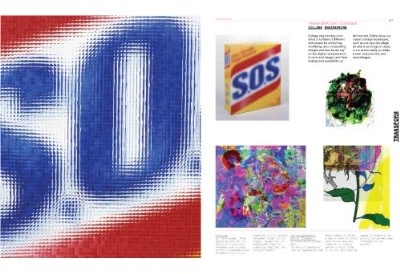
“Visualise” and “Simulate” are almost devoid of (non-computer) art historical examples and cultural context. Harold Cohen’s AARON is illustrated, and Douglas Hofstadter, Richard Dawkins and Stephen Wolfram’s ideas are mentioned. More people should know about the wokr of Hofstadter’s FARG, and the concepts, work and writing presented are still a treasure trove of information and inspiration. But these chapters lack the art historical context of their predecessors.
The contemporary visual art computing presented is mostly in the generative art / data visualisation mold. It’s highly structured, would mostly be impossible to produce without computers, and is haunted by the possibility of being merely decorative. The only academically recognisable critical art included is one of JODI’s less threatening browser pieces. But the example of worldmapper.org in the chapter on visualisation shows how the aesthetic tools of data visualisation can be used politically. And the formal structures and creative strageties of much of the art has a quality of realism in the age of networks that is a challenge to Theory rather than a falure to illustrate it.
The success of books intended to provide a comprehensive foundation in an area of the study of art, such as “Art In Theory” or “Basic Design”, have both helped to enrich the study of art and had the unintended consequence of closing off other possible narratives. Form+Code stands to be as successful in its own area as those books were in theirs, with the same benefits and dangers. Form+Code’s ommission of virtual reality, livecoding, and other movements within art computing are understandable given its focus, but hopefully won’t lead to their neglect by students.
Could you code up any of the software art that you see in the book after reading it? No. The only code listings are historical fragments. But after reading the book you will undestand the concepts that you need both to figure out what more you need to learn in order to program such art and to understand why doing so is aesthetically and art historically worthwhile. And some source code from the book, in various programming languages, is available online.
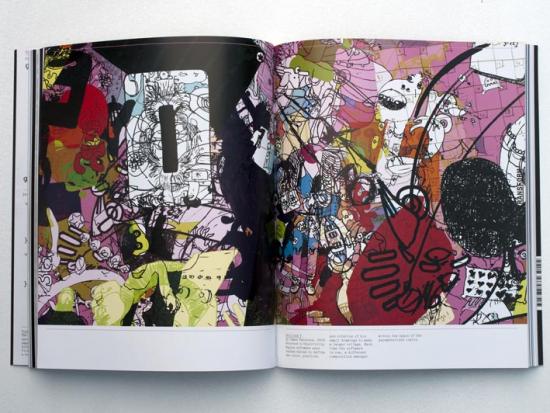
Form+Code’s major achievement is that it presents technical, art historical and technical historical information in such a way that it complements each other and builds a bigger picture that demonstrates the wider relevance and further potential of art computing programming. Having read it, you’ll know more and you’ll both want to and be able to learn how to do more. It’s clearly laid out, packed full of illustrations, occasional code fragments, plenty of references to sources for further investigation, and even has a good index. It really is a foundation course in a book, providing a sound basis for further learning or research.
If you teach art computing, and if you are teaching art, graphic design, textiles, fashion or architecture then you are teaching art computing to a greater or lesser degree, then Form+Code is a perfect primer for the conceptual, historical, and cultural side of computing and art computing. Outside of education, if you are involved in art, computing, or are a non-programmer computer-using artist Form+Code provides a good grounding in the concepts used in programming for art computing.
Form+Code serves as a complete introduction to the conventional history, concepts and practice of visual art computing. It presents that information in the context of the broader history of art and design. And it provides enou
Jaron Lanier
You Are Not A Gadget
2010
Allen Lane
ISBN 1846143411
Jaron Lanier’s book “You Are Not A Gadget” is a timely polemic, a cry of the soul in an increasingly soulless Web 2.0 world. I found reading it a frustrating and inspiring experience. For every time I wanted to throw the book at the wall in exasperation there was a time where Lanier spoke to a part of me that the cultural transition from 90s cyberpunk to 2010s cyberpreppy had optimised out.
Lanier is asking the right questions. What happens to our conception of what it means to be human when the way we represent our humanity is reduced to snippets of media on (micro-)blogs and social networking sites? How can we support a middle class of independent artists when the technology and economics of the Internet makes money directly only for the vectorialist media barons of Web 2.0? Will the technologically enabled troll class become a political threat akin to historical fascism?
These are questions that need asking, and Lanier asks them in an intelligent and open way. This is all the more impressive given his background as a champion of cyberculture. Lanier is not fearful or dismissive of the changes that the technology he championed has wrought. He is looking them in the eye and challenging their new proponents to explain the gap between their claims and their reality.
The problem is that Lanier’s answers crash and burn from a lack of detailed knowledge of non-cyber culture. He contrasts the managerialism and capitalism that he mis-identifies as materialism with a naive and easily exploited mystificatory spirituality. He accepts unquestioningly the music recording industry’s claim that the Internet has destroyed the economic and cultural value of music. And his characterisation of commons-based peer production as digital Maoism is wide of the mark.
To address just one of his examples; the cultural smog of the contemporary Internet follows the exhaustion of mass culture, it has not produced it. Napster is not to blame for the X Factor. The Beatles, generally regarded as a cultural highpoint of mass culture, were a reactionary throwback to earlier rock and roll tropes and were identified as such by Cliff Richard at the time. The well of mid-20th century black American music was returned to in the 1960s, 1970s 1980s and 1990s and was dry by the era of the parochial third-order nostalgia of Britpop. Crucially, Britpop pre-dates Napster and mass adoption of the MP3 file format. Lanier’s adopted narrative doesn’t add up.
But I come to praise Lanier, not to bury him in data. His is an ambitious critique, an important challenge to deeply ingrained cybercultural beliefs. We should all be so brave as to face the consequences of what we believe in so directly. And his final conclusions, not those of a disappointed cyber-hippy who should have been careful what he wished for but of someone who has kept faith in the potential of technology for us to realise ourselves, are as inspirational as they are accusatory.
You can google any number of blow-by-blow disagreements with Lanier’s thesis. And his own FAQ on the book is in many ways more convincing than the book itself. But if you have any interest in contemporary culture as it is mediated by technology you owe it to yourself to find your own points of difference and agreement with Lanier and to look beyond that to the spirit of what he is saying.
Which is that we should not be reifying and reducing our selves and our experiences into packets of data that the social robber barons of Web 2.0 can sell to marketing companies and government agencies. We should be using virtual reality and the other affordances of information technology to expand our consciousness and to grow as socialised individuals.
Web 2.0 can be oppressively straight and conformist. It doesn’t have to be like this. Don’t dismiss Lanier’s ambition to create a virtual reality system that could let him experience being an octopus. Wonder what it would be like to try it yourself, and how you would explain it to your friends.
Not the entries on your Facebook Friends list, your actual friends…
The text of this review is licenced under the Creative Commons BY-SA 3.0 Licence.
Article by Rosa Menkman
Based on an interview with the Critical Glitch Artware Category organizers and contenders of Blockparty and Notacon 2010: jonCates, James Connolly, Eric Oja Pellegrino, Jon.Satrom, Nick Briz, Jake Elliott, Mark Beasley, Tamas kemenczy and Melissa Barron.
From April 15-18th, the Critical Glitch Artware Category (CGAC) celebrated its fourth edition within the Blockparty demoparty and this time also as part of the art and technology conference Notacon.
The program of the CGAC consisted of a screening curated by Nick Briz, performances by Jon Satrom, James Connolly & Eric Pellegrino, and DJ sets by the BAD NEW FUTURE CREW. There were also a couple of artist presentations and the official presentation of a selection of the (115!) winners within the Blockparty official prize ceremony.
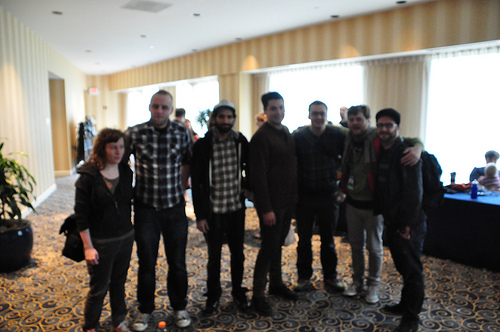
The fact that CGAC was coupled with a demoscene event is somewhat extraordinary. It is true that both the demoscene and CGAC or ‘glitchscene(s)’ focus on pushing boundaries of hardware and software, but that said, I (as an occasional contender within both scenes) could not think about two more parallel, yet conflicting worlds. The demoscene could be described as a ‘polymere’ culture (solid, low entropic and unmixable), whereas CGAC is more like an highly entropic gas-culture, moving fast and chaotically changing from form to form. When the two come together, it is like a cultural representation of a chemical emulsion; due to their different configuration-entropy, they just won’t (easily) mix.
But all substances are affected (oxidized) by the hands of time; there is always (a minimal) consequence at the margin. And this was not the first time these two cultures were exposed to each other either; Criticalartware had been present at Blockparty since 2007. Moreover, a culture can of course not be as strictly delineated as a chemical compound; it was thus clear that this year the two were reacting to each other.
While over the last couple of years the demoscene has been described in books, articles and thesis’, this particular kind of ‘fringe provocation’ is not what these researchers seem to focus on; they (exceptions apart) concentrate on the exclusivity of the scene and its basic or specific characteristics. The ‘assembly’ of these two cultures during Blockparty could therefore not only serve as a very special testing moment, but also widen and (re)contextualize the scope of the normally independent researches of these cultures. So what happened when the compounds of the chemicals were ‘mixed’ and what new insights do we get from this challenging alliance (if there is such a thing)?
The demoscene is often described as a bounded, delimitated and relatively conservative culture. Its artifacts are dispersed within well-defined, rarely challenged categories (for the contenders, there is the ‘wild card’ category). Moreover, the scene is a meritocracy – while the contenders (that refer to themselves with handles or pseudonyms) within the scene have roles and work in groups, the elite is ‘chosen’ by its aptitude.
The demoscene also serves a very specific aesthetics, as enumerated by Antti Silvast and Markku Reunanen this week on Rhizome (synced music and visuals, scrolling texts, 3d objects reflections, shiny materials, effects that move towards the viewer – tunnels and zooming – overlays of images and text, photo realistic drawing and adoption of popular culture are the norm). In the same article Silvast and Reunanen declare that: ‘Interestingly, even though we’re talking about technologically proficient young people, the demosceners are not among the first adopters of new platforms, as illustrated by numerous heated diskmag and online discussions. At first there is usually strong opposition against new platforms. One of the most popular arguments is that better computers make it too easy for anybody to create audiovisually impressive productions. Despite the first reactions, the demoscene eventually follows the mainstream of computing and adopts its ways after a transitional period of years.'[1]
More about this can be read at Rhizome’s week long coverage of the demoscene. Silvast and Reunanen’s statement might be most interesting when we move along to see what happened during the meeting of the two scenes.
Co-founded by jonCates, Blithe Riley, Jon Satrom, Ben Syverson and Christian Ryan in 2002, Criticalartware is a radically inclusive group that started as a media art history research and development lab. Since 2002 the group has shifted and transitioned. Criticalartware’s formation was deeply influenced by the Radical Software platform (publications and projects). Since then it has been an open platform for critical thinking about the use of technology in various cultures. Criticalartware applies media art histories to current technologies via Dirty New Media or digitalPunk approaches. Through tactics of interleaving and hyper threading it permeates into cultural categories of Software Studies, Glitch Art, Noise and New Media Art.
During the first phase of Criticalartware (from 2002 – 2007), the group was a collaborative of artist-programmers/hackers. It also functioned as a media art histories research and development lab. In this form, Criticalartware had become an internationally recognized and reviewed project and platform.
When this phase ended in 2007, jonCates, Tamas Kemenczy and Jake Elliott were the remaining active members of Criticalartware. During this time, Elliott and Kemenczy wanted to take the project in a new direction; into the demoscene. This direction has ultimately defined the second phase of Criticalartware; an artware demo crew, making work for and appearing annually at the Blockparty event and Notacon conference in Cleveland.
2010 marked the next important transition for the Criticalartware crew, when it started using the phrase ‘Critical Glitch Artware’- Category. Criticalartware now not only organizes itself around the demoscene but also around the concept of the glitch. While a glitch (not to be confused with glitch art) appears as an accident or the result of misencoding between different actors, CA’s Glitch-art category exploits this possibility in an metaphorical way. Criticalartware is now foregrounding these glitch art works (with an emphasis on the procedural/software works) that have been on a ‘pivotal axis’ of the crew for a long time.
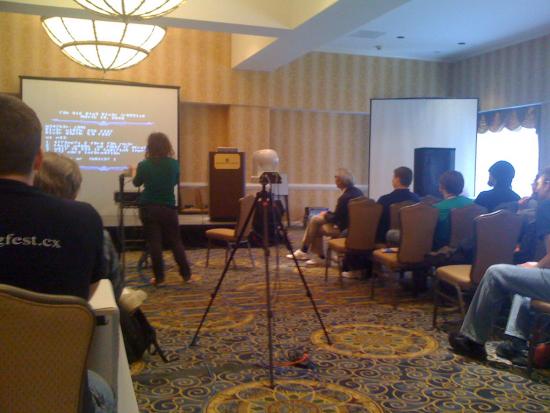
CGA, just like the demoscene, can be described as an open (plat)form for artistic activity/culture/way of life/counter culture/multimedia hacker culture and (unfortunately a bit of ) a gendered community. CA are about pointing out ideas or concepts within popular culture and incorporating (standardizing) these as machines or programs in a reflexive and critical self-aware manner.
CA can also be described as an investigating of standard structures and systems. They are often amongst early adopters of technology, in which they (politically) challenge and subvert categories, genres, interfaces and expectations. But the CGA – artists do not feel stuck in a particular technology, which makes it aesthetically, at least at first sight hard to pinpoint a common denominator.
There is not a real organization within this scene. The artists and theorists are scattered over the world, connected in fluid/loosely tied networks dispersed over many different platforms (Flickr, Vimeo, Yahoo groups, Youtube, NING, Blogger and Delicious).
Because of its bounded, intricate conservative qualities, the demoscene has been an easy target for outsiders to play ‘popular’ ironic pranks on, to misunderstand or misrepresent. A growing interest for the demoscene by outsiders has compelled jonCates and the Criticalartware crew to articulate their position towards the demoscene more extensively. In an interview with me, jonCates articulates Criticalartware’s points and contrasts these with problematic representations of the demoscene within two works by the BEIGE Collective (that in 2002 existed along side the Criticalartware crew in Chicago).
When the BEIGE collective went to the HOPE (Hackers on Planet Earth) Conference in 2002 they made a project called: TEMP IS #173083.844NUTS ON YOUR NECK or Hacker Fashion: A Photo Essay by Paul B.Davis + Cory Arcangel.
jonCates writes to me that ‘this problematic project characterizes or epitomizes a kind of artists as interlopers positionality that i + Criticalartware as a crew has always attempted to complicate. we do not want or understand ourselves as seeking out an ironic or sarcastically oppositional position in relation to the contexts that we choose to work in. we have not set out to ridicule the demoscene or otherwise make ridiculous our relations to the demoscene. in contrast, we set out to operate within a specific demoscene through multi-valiant forms of criticality, playfullness, enthusiasm, respect, interest, admiration, etc… this has also been in efforts to connect this specific demoscene to our experimental Noise & New Media Art scenes or what you Rosa referred to earlier as glitchscene…’
Another point of contention for jonCates is the Low Level All-Stars project by BEIGE (in this case, Cory Arcangel) + Radical Software Group (Alexander R. Galloway). this work is described as ‘Video Graffiti from the Commodore 64 Computer’ (2003) by Electronic Arts Intermix who sells/distributes this work as a video in the context of Video Art.
Low Level All-Stars has been shown at Deitch Projects in NYC in 2005 and circulated in the contemporary art world. jonCates writes to me saying the work seeks ‘to isolate + thereby establish cultural values for this ‘quasi-anthropological’ view of demos as found object + functioning as a tasteful ‘testament to a lost subculture.’ It is now being offered online as an educational purchase for $35 dollars.
However, as jonCates and Criticalartware work in the demoscene demonstrates, the demoscene subculture is not lost, nor over. jonCates moves on by writing that ‘the demoscene is a vibrant whirld wit a dynamic set of pasts + presents. this is another of which many (art) whirlds are possible. we seek to make those whirlds known to each others + ourselves out of respect, curiosity, investment, inclusiveness, criticality, playfullness, etc…’
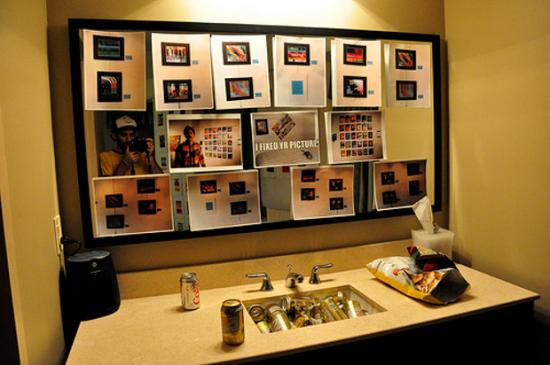
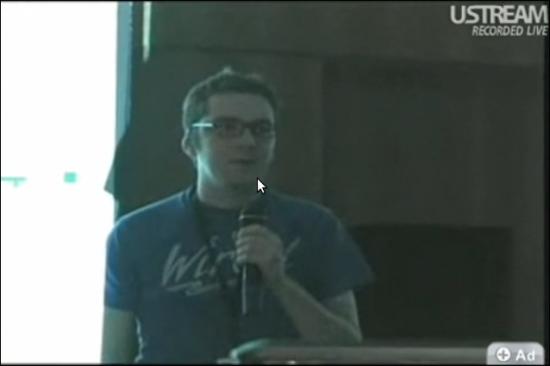
The Criticalartware crew has been taking part in Blockparty since 2007, when it won the last place in a demo competition and was disqualified. One year later, in 2008, through a number of efforts (including Jake Elliott’s presentation Dirty New Media: Art, Activism and Computer Counter Cultures at HOPE, the Hackers on Planet Earth conference in NYC in 2008). CA was able to mobilize and manifest the concept of the Artware category at Blockparty, a category which Blockparty itself retroactively recognized CA for winning.
In the same year (2009) CA organized a talk at Blockparty in which they revealed the “secret source codes” of the tool they used to develop the winning artware of the year before.
By 2010 CA wanted to expand the concept of Artware within the demoscene, which lead to the development of the ‘Critical Glitch Artware Category’ event. Within the CGAC Compo there where 115 subcategory winners, which showed some kind of glitch-critique towards systematic categorization of Artware. Jason Scott (the organizer of Blockparty) personally invited CGAC to pick 3 winners and present their wares at the official Blockparty prize ceremony. Besides these three winners, CGACs efforts got extra credits when Jon Satrom’s Velocanim_RBW also won the Wild card category compo.
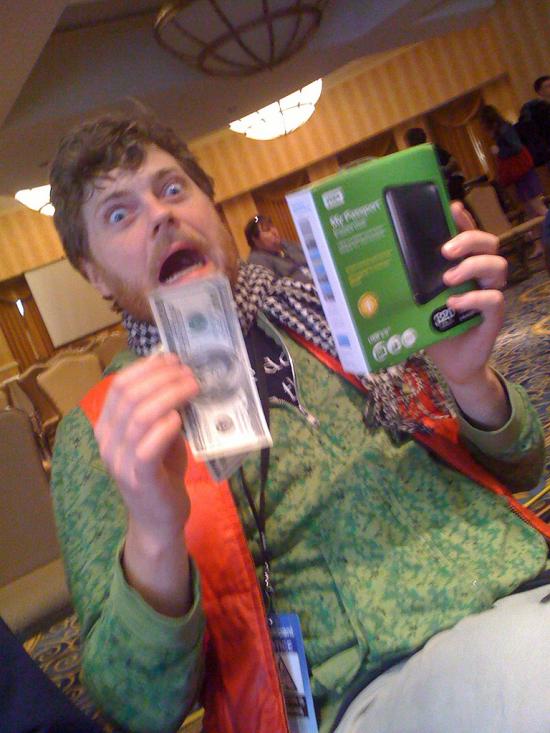
Therefore, not only did CA intentionally open up the Blockparty event to outsiders of the demoscene, it also provided a place for new media art and the glitchscene within the demoscene and got Blockparty to accept and invite the CA within their program. Thus, the outsiders (CA) moved towards the inside of the event, while the insiders got introduced to what happens outside of the demoscene (event), which led to conversations and insights into for instance bug collecting, curating and coding.
The Critical Glitch Artware Category has been accepted by, at least, the fringe of Blockparty 2010. Even though the category itself is not (yet) visible on the website, Satrom’s winning work Velocanim_RBW is. Moreover, CGAC was part of the official prize ceremony, streamed live on Ustream, the live Blockparty internet television stream. So how does CGAC redefine or reorganize the fringe between them and the demoscene and how does the demoscene redefine and reorganize the structure of CGAC?
For now, I think crystallized research into the aesthetics of the demoscene can also help describe the aesthetics within CGAC. Custom elements like rasters, grids, blocks, points, vectors, discoloration, fragmentation (or linearity), complexity and interlacing are all visually aesthetic results of formal file structures. However, the aesthetics of CGA do not limit themselves, nor should they be demarcated by just these formal characteristics of the exploited media technology.
Reading more about the demoscene aesthetics, I ran into a text written by Viznut, a theorist within the demoscene (who also wrote about ‘thinking outside of the box within the demoscene’). He separates two aesthetic practices within the scene: optimalism (an ‘oldschool’ attitude) which aims at pushing the boundaries in order to fit in ‘as much beauty as possible’ in as little code necessary, and reductivism (or ‘newschool’ attitude), which “idealizes the low complexity itself as a source of beauty.'[2]
He writes that “The reductivist approach does not lead to a similar pushing of boundaries as optimalism, and in many cases, strict boundaries aren’t even introduced. Regardless, a kind of pushing is possible — by exploring ever-simpler structures and their expressive power — but most reductivists don’t seem to be interested in this aspect”.
A slightly similar construction could be used for aesthetics within Glitch Art. Within the realm of glitch art we can separate works that (similar to optimalism) aim at pushing boundaries (not in terms of minimal quantity of code, but as a subversive, political way, or what I call Critical Media Aesthetics; aesthetics that criticize and bring the medium in a critical state) and minimalism (glitch works that just focus on the -low- complexity itself – that use supervisual aesthetics as a source of beauty). The latter approach seems to end in designed imperfections and the (popularized) use of glitch as a commodity or filter.[3]
Of course these two oppositions exist in reality on a more sliding scale. Debatebly and over simplified I would like to propose this scale as the Jodi – Mille Plateaux (old version) – Beflix – Alva Noto – Glitch Mob – Kanye West/Americas Next Top Model Credits continuum; A continuum that moves from procedural/conceptual glitch art following a critical media aesthetics to the aesthetics of designed or filter based imperfections.
This kind of continuum forces us to ask questions about the relationships between various formalisms, conceptual process-based approaches, dematerializations and materialist approaches, Software Studies, Glitch Studies and Criticalartware, that could also be of interest or help to future research into the demoscene. When I ask jonCates what other questions CGAC brings to the surface, he answers:
“when i asked Satrom to participate in the CRITICAL GLITCH ARTWARE CATEGORY event + explained the concept that Jake + i had developed to him he was immediately interested in talking about it as form of hacking a hacker conference, by creating a backdoor into the conference/demoscene/party/event. im also excited about this way of discussion the event + our reasonings + intentions, but i want to underscore that this effort is also undertaken out of respect for everyone involved, those from the demoscene, glitchscenes, hackers, computer enthusiasts, experimental New Media Artists, archivists, those who are working to preserve computer culture, Noise Artists + Musicians, etc… so while this may be a kind cultural hack/crack it is not done maliciously. we are playful in our approach (i.e. the pranksterism that Nick refers) but we are not merely court jesters in the kingdom of BLOCKPARTY. we have now, as of 2010, achieved complete integration into the event without ever asking for permission. perhaps that is digitalPunk. + mayhaps that is a reason for making so many categories +/or so many WINNERS! 🙂
…also, opening the category as we did (with a call for works [although under a very short deadline], an invitational in the form of spam-styled personal/New Media Art whirlds contacts + mass promotional email announcements of WINNERS! (in the style of the largest-scale international New Media Art festivals such as Ars Electronica, transmediale, etc…) opens a set of questions about inclusion.
…whois included? who self-selects? whois in glitchscenes? are Glitch Artists in the demoscene? etc… this opening also renders a view on a possible whirld, which was an important part of my intent in my selection of those who won the invitational aspect of the CRITICAL GLITCH ARTWARE CATEGORY. by drawing together (virtually, online + in person) these ppl, we render a whirld in which an international glitchscene exists, momentarily inside a demoscene, a specific timeplace + context.”
Lately the demoscene seems to get more and more attention from “outsiders”. Not only ‘pranksters’, artists and designers who are interested in an “old skool” aesthetic, but also researchers and developers that genuinely feel a connection or interest to a demoscene culture (I use ‘a’ because I think there still should be a debate about if there might be different demoscene cultures).
This development makes it possible to research a subculture normally described as ‘closed/bounded’ and to see where and how these different cultures are delineated. The tension between Blockparty/Notacon and Critical Glitch Artware Category is one that takes place on a fringe. They do not come together, but while it would be easy to just think that probably the CGAC sceners were just ignored (and maybe flamed) by the demosceners half of the time, some more interesting and important developments and insights also took place.
The CGAC-crew has over the years shown itself to be volatile, critical and unexpected, but it has also shown respect to the traditions of the demoscene and in doing so, earned a place within this culture (at least at Blockparty). This gave the CGAC-democrew not only the opportunity to put a foot in the backdoor of a normally closed system, but also to give some more insights into what they expose best: they confronted the contenders with their (self-imposed) structures and introduced them to (yet to be understood and accepted) new possibilities.
So what happens when a polymere is confronted with entropic gasses? I think the chemical compounds get the opportunity to measure the entropic elasticity of their dogmatic chains.
Also read:
Carlsson, Anders. Passionately fucking the scene: Skrju.
http://chipflip.wordpress.com/2010/05/20/passionately-fucking-the-scene-skrju/ Chipflip. May 20th, 2010.
When it comes to questions concerning art and blogs, one has to resolve the distinction between blogs dealing with art and blogs being the art. When the editors of Artkrush #57 enlisted Tom Moody’s weblog in their art blog selection, it was included in the former category. But is the latter forbidden for a blog like Moody’s, which, besides containing political thoughts and remarks of other artist’s work, contains entries of the author’s work?
Tom Moody is an American artist who started as a painter and later adopted lo-fi techniques of computer aesthetics that deal with the ubiquitous Internet commercialism and ever-present kitsch of web culture. A focal point of his work is painting molecules. It’s plain enough that every pure notion of objects and their relations (such as the depiction of molecules) invites an immense plethora of interpretations, possibly drawing on sarcastic commentary like “nothing is said when everything is said”. But the structure also implies an important point of absence of contingency, “intension abstracted from extension,” an underlying structure present in every phenomenon of human acts of objectification. The recurrence of molecules in Moody’s work yields “as a matter of essence and an essence of matter”, a crossing point of latent inner structures and omnipresent superficiality.
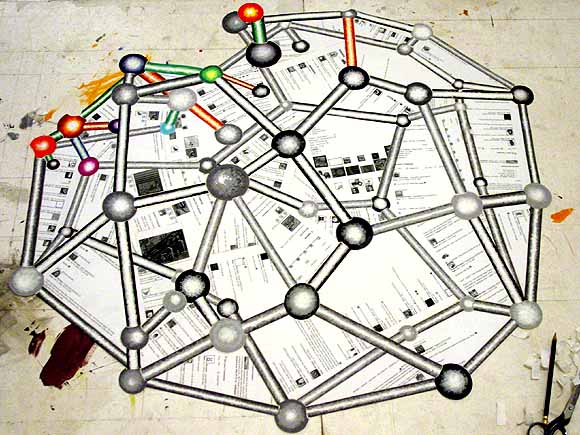
In his recent work called BLOG, Moody puts his web blog in a white box gallery space. Viewers could approach a simple installation of a computer monitor, keyboard and mouse to browse an artist’s blog in artMovingProjects Gallery in New York. The month-long exhibition, from May 19 to June 24, didn’t change Moody’s blogging routine, though perhaps besides having an awareness of the gallery audience. He considers this the second generation of “net art”.
“I’m going to be performing with changing content, graphics, etc. Not really any different from what I normally do, but with an awareness of a specific, meat space audience, what will work on the gallery’s screen, how to explain to a reader not physically in the gallery what I’m doing and why,” writes Moody on his blog. He reflects on the exhibition occasionally, but most entries are written in a standard manner, following the purpose and tone of Moody’s writing before the exhibition.
“The weblog is a combination of things: it’s a studio diary; it’s an ongoing documentation of past work; and it’s a place for work-in-process, as well as collaborations, original pieces made for the web, and mini-curated exhibitions of things I like (of both an art and a web-oddity nature),” Moody explains in an interview for NY Arts.
What is most interesting about BLOG is Moody’s reflection of the performance, as in what escalates the recursive nature of the concept additionally illustrated by the author himself: it is “BLOG on BLOG during BLOG.”
An artist’s ego has always played an important role in the art world, but within social media culture, one doesn’t have clarity of an artist’s front and back stage. It is supposed to be considered art if it is put it in an art context, like a gallery, but does that mean that everything else isn’t art? Weblogs, and the web in general, have proved to be successful outlets for art. The gallery context is no longer the only legitimate venue for presenting art, adding another dimension to Marcel Broodthaers’ notion of an artist being an author of definition since Duchamp’s era.
Truly, the tongue-in-cheek situation stems here from Moody’s decision to make public something that is already public in a full-fledged way. Furthermore, visitors are invited to interact through commentary on the web page in the curatorial text and Moody’s blog entries. The duality of perception brings about a duality of the audience. Blog art can easily blur the line between artistic content and curatorial mission. However, Tom Moody isn’t concerned with curating immateriality. This plain overlap of understanding art as actual and virtual, institutional and lively, makes his performance an important gesture.
lost in metamorphosis: ursula endlicher’s html_butoh
Butoh is enigmatic. Sometimes characterized as dance, sometimes as theatre, sometimes as meditation on what it means to be human, butoh seems to resist definition and easy categorization. Undeniably, however, butoh is about movement. Butoh emerged in post world-war II Japan, in part rising out of dissatisfaction with the prevalence of Western dance movements and influences in that country. Some have suggested that the goal of butoh is for the dancer to cease being him/herself, to stop being human, and to become instead another entity altogether. If butoh drives the human out of the dancer through movement, Ursula Endlicher’s html_butoh “a web-driven performance piece” raises questions about humanness in the realm of the internet.
Html_butoh is based on Endlicher’s movement library, “a web-based repository of short video clips and images by various performers who use html tags, such as,,, as a starting point for generating movements.” Anyone can submit a video clip to the library. Uploading a video allows you to be integrated into not only the movement library, but also html_butoh’s code recital. The performances of html_butoh come to fruition when a particular website is enacted or read. What results is a five by five grid of video clips from the movement library, each clip corresponding to a particular line of html code (,, or for instance). The websites that form the basis for these performances are culled from the ‘global top 500’, a listing ?updated daily” of the most popular websites based on traffic.
In the collaborative, mutable play of html_butoh, all the web is a stage and the performers flit from page to page. One of the webpages on which both they and I landed was [url:http://msn.foxsports.com/]Fox Sports[/url]. With a click, I surfed away from the hypnotic movement and sound of html_butoh, to the steely gray and blue of the Fox Sports website, peppered with images of athletes. It was hard to remember that what I saw in each was the product of the same code interpreted two different ways. I had to force myself to see the Fox website differently, imagining in it the invisible structure that was being so vibrantly performed on html_butoh. The video performers of Endlicher’s work make visible the invisible workings of web surfing, embodying and humanizing it. It is the interpretative work, the decoding, executed by the web-butoh dancers, that drives html_butoh. And it is their work that makes the web-performance so fascinating, no two individuals moving, acting, or looking alike. Some of the html_butoh dancers are costumed, one in toga like robes and head wrap, holding a spear, like Athena, rising fully formed from the net itself. Some, in contrast, are dressed in street clothes, one wearing a bulky coat and carrying a large green purse while she moves in looped translation of the command. The juxtaposition of stage and street is intriguing in a work that is at once randomly generated and wholly constructed.
It is tempting to think of what html_butoh offers as a simple translation, the rendering of code into movement through a sort of ‘open-source’ improvisational dance troupe. Certainly, translation seems to be central to some of Endlicher’s other web-driven works. Websitewigs for instance, renders the hypertext structure of the web into a series of interconnected wigs, each braid based on links and codes that underlie what we see when we look at websites. Singing Website Wallpaper enacts a form of double translation, reinterpreting html code first as sound, then translating that sound into a visual symbol. Although the movement library develops an ‘expandable movement alphabet of the html library’, translation is only part of the equation in html_butoh.
Endlicher makes visible what for many is an unnoticed and unintelligible structure operating behind what we see in a web browser. As we watch, the ways in which browsers scan html code in order to display its content is performed as movement. But what is it that we are really watching? Butoh dancers do not simply imitate, they become. Recalling the ethos of butoh, what takes place in Endlicher’s work is not just translation, but metamorphosis. Websites are not simply reinterpreted; rather they become something else altogether. If Endlicher is humanizing the web, she is also mechanizing humans, their movements and bodies caught in digital code, endlessly looping as we watch. Endlicher’s piece takes place at the intersection of the organic and the inorganic, human and machine. The work shifts seamlessly from the human act of looking to the calculated act of scanning. Endlicher’s work challenges the seeming separation between us and the machines we use, asking questions about the inner workings of both.
“Ultimately there are only two basic states or basic phases and everything of interest takes place on the boundary between them: on the boundary between chaos and order, on the boundary of water and ice, on the boundary of finite and infinite computer process.” Tor Norretranders*
Kate Southworth and Patrick Simons have been creating audiovisual artworks, output in Shockwave, for exhibitions, projections at public gatherings of various kinds and for distribution across the Internet since the year 2000.
They live and work in Cornwall, under the name Glorious Ninth, which they describe as the space between their different approaches. Tor Norretranders, in his book, The User Illusion, tells us that when you have both ice and water in the same glass, complexity occurs at the transitional point between solidity and fluidity. It is on this boundary that really interesting things happen. By tracking back through the history of the evolution of human consciousness, he suggests that consciousness and culture both exhibit this common quality with matter.
Packet Switching is described by the artists as an encounter with the “liminal space between ocean and land, between emotions and thoughts, and between reality and virtuality”. It exists simultaneously in two forms, as an online work and, for the next two years, in physical space as part of the touring exhibition, net:reality. The first venue is 20/21 Gallery in Scunthorpe, in a deconsecrated church.
A fine mesh screen of 4′ x 5″ is suspended in the nave of the church, above visitors’ heads, with a moving image back-projected onto its surface so that it can be seen from both sides. The audio plays from speakers situated on the floor on either side of the screen forming a triangle measuring about 18 feet, on each side. The sound creates a focal point that positions the viewer in front of the work. The moving black and white image consists of a cascading repeated text “we learn to love within the womb” which ebbs and flows in waves from the top of the screen over a series of images, abstracted through the application of image filters. Unlike the Internet version of this piece, that allows the viewer to “enter” the work at the “beginning”, in the physical space one is never sure how close one is to the start or the end of the 37 minute cycle. This sets the work in infinite time-space.
Online, some minimal colour is introduced and the first image, a flickering (wild open) eye, fills the screen for a number of minutes before being obscured by the text. This image strongly influences the way in which one experiences the rest of the work. The eye is eventually replaced by increasingly subtle imagery: of foliage, of the sea against the rocks, solarised, in negative. These are in turn masked by text which flows and drags across it like black oil across glass. Combining the visual qualities of an all-over, expressionist painting and a long film loop, it is a continuously moving, pulsing abstraction.
The sound track is created from a series of field recordings. We hear a collection of mixed sounds, many of which are produced by walking: foot-fall, clothes brushing against clothes, ambient reverberations from coastal walks. The raw sound is cut, layered and serialized to suggest the whooshing rhythms of the sea or the ocean, even a locomotive train, in an imaginative recycling of the sounds of natural and mechanical motion that exist in the artists’ everyday locality.
Imagine sitting on the rocks on a beach in Cornwall, together with a friend or lover. Surveying the shapes and rhythms where waves repeatedly meet the slopes of a beach- the ocean, alive, resonating its presence, you watch the chaotic coordination of dancing droplets, spraying and dragging shells and varied life forms across the surface of the sand. Here, the longer and more closely you observe, the more strongly you can recognise the complex audiovisual, phasing patterns that evolve in Packet Switching.
Southworth and Simons create the audio and the visual elements of the piece independently. They negotiate the content, structure, texture and the feel of the work through conversations and by creating collaboratively drawn spider diagrams. Neither strand of the work is there to illustrate or to constrain the other. One might expect this process to lead to either long periods of disjunction in the work or to an undifferentiated sameness in the relationship between audio and visual tracks. But instead it offers a demonstration of the inevitable emergence of a new complex strand arising from the dynamic interaction between established, distinct forms.
This work does not reflect one individual’s internal psychology or singular skill, but declares the artists’ mutual way of working as two individuals, exploring their experience of the world, between and around them. In the current theoretical debates surrounding media art practice there is a growing interest in the potentials of digital media to facilitate collaboration. These can range from the abstract to the ideological and claim to do some of the preparatory work for artists- to create the field. Packet Switching is an explicit examination and imaginative response to love, landscape and liminal space; rather than relying on already constructed theories or prescription it develops through process as an actual manifestation of collaborative creativity.
*The User Illusion: Cutting Consciousness Down to Size by Tor Norretranders
Published 1991 (in Danish), 1994 in English by Penguin Books
NET:REALITY is a touring exhibition
currently on show at 20-21 Visual Arts Centre, Scunthorpe, UK”
Much of Lo_y’s work is poetic and dynamic in its conception rather than in its functionality. The deliberate assembling of text & character symbols in earlier works has referred to the formal possibilities of the code behind digital content, making it its subject. These are abstract works, stripped of narrative, subjectivity or political slant.
030807 marks a new direction for L_oy, as previous work has consisted of high-colour, static HTML code texts on strongly contrasting backgrounds. I have enjoyed the austere Greenburgian qualities of these earlier works, where the only interaction required to view them is to scroll down or across on your browser. This piece, in some ways, is more ambiguous in its pursuit of bare-bone aesthetics. With this work (unusually, made in Flash), the formal essence and non-representational focus are revealed by the user’s exploration of the page. As one clicks and moves one’s mouse over the organic silhouette forms, ranged in a grid across the page, they morph to reveal sigils.
In a recent message on August Highland’s site, I noticed a statement from Lo_y. It went, “well, there’s not much to say. Lo_y is only what Lo_y writes. No history, no stories, no explanations…“
So I better shut my mouth.
Featured image: Monochromatic and dichromatic grids, stitched together via javascript
if (jimpunk=3D=3Dprozac)…
You can’t escape jimpunk. I tried, believe me: it was easy to be disillusioned with net.art, with so many new works showing up on the list-servs plunging so far into the morass of conceptualism that both the “net” and “network” properties that have always distinguished the medium seem to have submerged somewhere deep below the surface of the current aesthetic set as to be almost imperceptible. I definitely don’t want to write this essay, much less look at jimpunk. I think this net depression began for me around the time I encountered a piece by Eryk Salvaggio in Whalelane that was, if I remember, purporting to be an “mpeg haiku.”http://www.whalelane.com/esalvaggio_mpeghaiku_house.html . What I got when clicking here was a few linear, non-interactive films of jets in the sky and other objects visually reminiscent of straight lines. As a conceptual gesture, the work was genius: an extended pun on the form of haiku, the video being “linear,” the jet trails being “linear” (ah, but look, look at the tension in that: it’s a linearity we see melt away before our eyes): each video also being a line. Yes, beautiful when I thought about it. But for some reason I craved spectacle, the sensual: I had been poisoned by Horace, searching art to give me “pleasure.”
So Marc said, well, write something about jimpunk. Take this link. The red pill, the blue pill. Marc sent me to http://www.jimpunk.com/_____________1_____________/, which I, attempting to exonerate myself from my recent deep-fried badness, tried. I was suspicious at first: wasn’t jimpunk illegal in the States? What if my mother walked in as I was looking at one of jimpunk’s sites; what would she think? So I chose the dead of night to schedule my visit, and prepared myself by insuring that everyone in the city was asleep. I was able to do this by paranoiacally peeping out all windows and doors in my apartment, and making sure I smiled extra wide at any old ladies I ran across in the city during the day. No base sensualist would smile so brightly!
jimpunk snaps on your screen with all the verve and whimsy of Stuart Davis . Remember Stuart Davis? Situated somewhere between dada and early abstract expressionism, Davis dipped a paintbrush in the conflagration and cacophony of emerging urban life, then wrung it across every canvas he touched. He inherited from Braque and Picasso a feverish urge toward college, and a love for the detritus of modern life. Just as Picasso’s daily newspaper nudged its way into certain compositions, the new neon signs and electric boulevards of cities bubbled out of the confusion of color that Davis felt.
But there’s something, well, much more primal, almost tribal, in this here site of jimpunk’s. He has a fondness, in ______________1_______________, for the visual impact of early video games—pixelization, my friend: monochromatic and dichromatic grids. The site seems to be a collection of animated DHTML pages, stitched together via javascript, to reload and refresh randomly into each other. One fullscreen composition melts into another; images, functioning here (WARNING: CONCEPTUALIST INTERPRETATION AHEAD!!) as tropes, collide both metaphorically and literally across your screen, sketching thin strands of association. Is that a young Don Knotts I see there, Marc? Is that Pac-Man?
These grids and boxy robots that slither and flit across the screen remind me of Native American textiles . Can you see it? Does not the cheesy robot, black and white and square all over, evoke for you earlier representations of man, lost (or fully in control?) of a halo mosaic of phenomena, of WORLD? Not to imply that jimpunk is working in a digital primitivistic style here; the work seems innocent, yes, but not naive: this resemblance to earlier textile artforms is intentional, and there seems to be some irony involved as well: you, as audience for this work, are invited to make the connection between the past and the present, between navajo textiles and early ’80s Pac-Man, not simply on the visual level, not simply in similarity of pattern, but also ideologically. With the lingering war in Iraq on everyone’s minds, and the United States in particular sliding backwards into a fascistic mode of government post 9/11, jimpunk seems to be laughing at us–not harshly, mind you; it’s a gentle, chiding laughter. jimpunk is no cynic.
It’s that lack of cybicism and gentle criticism that helped me past my net depression. After a few nights of clandestine visits to jimpunk’s project, I feel much better about net.art, even hopeful in my own way. I have, however, noticed certain sexual side effects; the toaster has been looking mighty attractive these days, and I get a strange fluttering thrill now whenever I plug data cables in…
Featured image: Screenshot from an online magazine that advertises sex with others
Ivan Pope’s latest work and project ‘Couples’ crawls into one’s psyche as he manages to unearth a seemingly timeless activity that, in the contemporary world, functions as a networking activity between millions of people worldwide. We are all now probably accustomed to the idea that it occurs on the Internet and that there are swingers regularly contacting each other and arranging liaisons through it. Instead of concentrating on such subterranean mutuality and its pursuits on a digital medium like the Internet, Ivan has collected his information from a magazine such as ‘Matchmaker’.
Yet this is not the only magazine out there being rabidly collected by these flesh swappers (may be you are interested). Many of them possess curious titles such as ‘Women in Jail’, ‘Adult Fun Times’, Liberated Women’, ‘Fads and Fantasies’, ‘Subs and Doms’ and of course ‘Couples’. They are usually bi-monthly issues containing contact catalogues showing explicit photographs of people exhibiting themselves.
The works that you see here are a small selection of a much larger growing collection. In actuality they are presented in the form of larger Inkjet prints, measuring up to two meters high. Thus reflecting upon our selves the viewer when observed (in the flesh) a human scale experience. This consciously aware figurative art declares a social context showing text with the images of people’s measurements, eyes and hair colours, height, false and alias names, desired requirements and contact details.
James Hillman the Archetypal psychologist said that ‘The sexual fascination is the soul trying to get out and get into something other than itself’. Which kind of explains not just the functionally of this habitual occurrence to a small degree but it also casts light upon the emotional side of it and why there are so many people out there in the world trying to meet each other this way, even when it seems that they are content with being with another singular loving entity. A subculture that swaps flesh not only goes through the process of swapping their physical selves, their bodies but also they share consciousnesses. There is a sense that many people feel an intense urgency to fulfill their desires (not need) by immersing their physical frames with others. Exploring their anonymity, letting go of the everyday nonsense that we all have to deal with, such as politics, paying bills, family struggles, wars and even love.
‘I was carried by the conviction that I rejoiced in extraordinary freedom. To fuck above and beyond any sense of disgust was not just a way of lowering oneself, it was to raise your self above all prejudice. There are those who break taboos as powerful as incest. I settled for not having to choose my partners.’ Catherine Millet. The Observer, Sunday May 19, 2002.
As I look at ‘Couples’ I am subjected to the unnerving realization that what I am seeing is also a kind of cattle market, flesh being sold on to those who long to possess them. They are also actually photographic images of real people rather than illustrations, cartoons, paintings; adding weight to the pieces with an undeniable raw intensity. Yes, it is dark. Yet it is also a barometer, a brutal signifier carrying with it an honest realism that we are more complicated, more connected to our visceral and feral identities than supposed civilized society acknowledges and lets on and informs us all to be.
Featured image: August Highland collaborates with William Shakespeare with the start of an going series of sonnets.
AUGUST HIGHLAND/WILLIAM SHAKESPEARE
By now most net artists, curators, net art viewers & related academics are aware of the perpetual antics of August Highland and his networked literary identities. They would also be aware of the non-stop emails that are poured into various lists, like liquidized data streams. Highland’s textural multi-presences bewilder some and subject others in peer positions to envy such fluid dedication.
It’s as though August is a machine, a ghost on automatic drive, asserting an existential punk spirit whilst going through the motions of spewing out into the void the essence of language as a pure medium, exploiting the Internet as a conduit, a space that needs filling. A quantum-digital type of universality or inclusiveness occurs, suggesting that our minds are part of a greater sum. We easily connect to the Internet now and do quite comfortably become part of the matrix.
Broadcast me, scrambled clean
Or free me from this flesh
Let the armchair cannibals take their fill
In every cell across wilderness
We’ll trip such a strangled tango
We’ll waltz a wonderland affair
Let’s run to meet the tide tomorrow
Leave all emotion dying there
In the star cold beyond all of your dreams
(I want to be a machine, Ultravox 1977)
We are psychologically and emotionally entwined, wrapped in a never-ending abyss of The Body Electric. For the virtual electronic waves, networks that August is currently filling are not far from the patterns of our own physical brains. As time goes by, we might begin injecting his work into our craniums, stimulating our neurons much like smart drugs or medication, as we become a multitude of consciousnesses connected via digital intersections.
One of August’s more recent explorative and playful manoeuvres is a sideways step from his usual all-out Internet infiltrations. This time he collaborates with William Shakespeare. Sonnets by the Superheroes of Humanities is a net-based, single-page object featuring the voice of the late Sir John Gielgud, which is the beginning of an ongoing project to do all of Shakespeare’s sonnets.
When entering the page, you are faced with a presentation of cut-up texts in five sections from the sonnet. In the centre lies the original text, unfettered by the artist for viewers to see before it is garbled. The rest of the four sections are various differentiations, digressing into visual text data. Java scripted words cut up, each possessing its own mannerism, function and movement. One section retypes, another shakes. Also, one can interact by mixing poems or words into sections or palettes.
It is worth venturing to see some of the other identities of August Highland to understand where he is coming from:
“Highland’s work here may on one level be a parody of the entire concept of the “art movement;” inasmuch as the postmodern has been characterized as “the end of movements” and an art era beyond manifestos; Highland, in a bold conceptual move, has birthed an art movement, complete with varied practitioners, from just himself.” -Lewis Look. Multiplicity: Notes for/on August Highland. October 15, 2002. Suite101.com.
Featured image: Two web cam installations by Ivan Pope – Lost Magic Kingdoms and Tabletop
Web Cam Theatre – two web cam installations, Lost Magic Kingdoms and Tabletop by Ivan Pope
Objects are cast in a performative context displaying motion and time using Internet technology. By using very basic equipment, cheap web cams, cheap software, cheap objects Ivan has created a twilight world. We witness a psychogeographically influenced environment that engages a fluent mix of conceptual and poetic crossovers with performance/live action. The installation is minimal, with light settings, the quality of the image and time based changes largely uncontrollable.
When you click onto the page of ‘Lost Magic Kingdoms’, images slowly cascade before your eyes down the browser page. You discover its history, with different times and moments of the day recored by two cameras on either side of a small table, enclosed by a screen. The cameras take it in turn to transmit the scene. Inspired by an installation made in 1987 by Eduardo Paolozzi, called Lost Magic Kingdoms and Six Paper Moons, revealing how art could be constructed by rearranging existing objects. With ‘Tabletop’, a single camera is mounted on a tripod. The lights go on and off. The camera pans the tabletop, looking for action and a new world is created.
These two web cam installations will be live until September 20 2003. The format will remain the same, but the objects and arrangement will vary. The rate of image change will also vary.
Both works show the relational nature of objects, a kind of magical realism falls into place like an Angela Carter’s ‘Nights at the Circus (1984), half human and half mythical; between actuality, the physical and the virtual, reality and non-reality. Changing every six minutes, you know that something is going to happen but the timeline is relative to your own modem, your own situation, and your own desires.
“The Space Between Analog and Digital”: Alan Sondheim’s Recent Executables
I’ve developed, over the last few years, certain assumptions about software art. Just browse through the many entries available at runme.org (http://runme.org/), and you, too will likely come away with some of these assumptions: that software art is, at its heart, utilitarian; it functions, it does something; it’s tool-like; it’s often more software than art.
Over the last month or so, July and August 2003, the writer Alan Sondheim has been happily chipping away at those assumptions. Alan is well known to netizens for his writing, which operates at the hinge of language and machine code; what isn’t so well known about him is that he’s spent some time programming–indeed, has been programming since at least the 1970s. A careful visitor to his monumental text work Philosophy and Psychology of the Internet (also known as the Internet Text)(http://www.anu.edu.au/english/internet_txt/), will see that Alan has, embedded in the text, some brilliant source code for Quick BASIC, the revival of the old BASIC language once shipped with all Windows PCs. He has written in Perl as well–see his Julu at runme.org (http://runme.org/project/+sondheimjulu/).
I’ve developed software art with Alan’s inspiration in mind myself–the application sondheim.exe (http://runme.org/project/+sondheim/) is a text editor written in Visual Basic designed to transform user input based on a configurable timer. The idea for this piece was wholly Alan’s; in electronic conversation, Alan mentioned that he had once, in the 1970s, written a similar application.
It was shortly after I wrote sondheim.exe that I mailed Alan a copy of Visual Basic, the object-oriented application development environment, developed by Microsoft, based on the old BASIC language. Visual Basic is about as close to English as one can get in the higher-level programming languages; it eschews the funky syntax most other languages have inherited from C, and which is often one of the more apparent stumbling blocks for new coders. And yet, despite its seeming simplicity, it succeeds as one of the most powerful Rapid Application Development (RAD) packages for Windows programming; one can do with Visual Basic almost anything that can be done in C and C++; indeed, if it weren’t for the fact that VB is exclusively a Windows programming tool, it might even approach that paragon of portability and power, Java.
Alan took the tool and ran with it. His characteristically unique vision, combined with his agile sense of mathematics, has produced a series of standalone executables in Visual Basic that are challenging the very core of what I had always assumed software art was about–creating strange and wondrous tools, creating functional pieces that interacted with unsuspecting users.
Alan’s recent Visual Basic works are nothing like that at all. These are not tools in any sense of the word. They’re only minimally interactive; usually, all one of these works require to get started is one simple mouse click from the user. Instead of crafting a functional artistic tool, Alan Sondheim has, in these works, highlighted the very processes one’s computer uses. These are narrative works, in the skin of software.
Anyone who has downloaded these is doubtlessly scratching their head right now, thinking, “Narrative? What’s narrative about watching an image dissolve or be defaced in some pre-programmed way?” Well, I understand your consternation. I’m not the most stable of people. Children run away from me when I smile.
Be that as it may, I’m sticking to my thesis: these executables are narrative; what we’re watching, when we download and run this software, is, as Alan himself states, “mathesis transform(ing) semantics…” And here’s how:
The Archaea Series
This is where I first began to notice the gist of Alan’s work in Visual Basic. The Archaea series consists of ten executables; they are all predicated on the dissolving and warping of images based on mathematical processes. The most vivid in the series is archaea3, downloadable here: http://www.asondheim.org/portal/archaea3.exe .
“The programs are operating in the space between analog and digital, although totally grounded in the digital,” Alan writes. “What are they deconstructing? Language, meaning, symbols, the symbolic. Through erasure and the growth of form.”
We’re confronted with a very red image of breasts pressed up against some glass when we first open archaea3. The glass is beaded with moisture; either the light or the filter makes the water gleam a sinister red. When we click on the image, what looks like static begins to eat away at the scene from left to right, very slowly; the static looks like it’s wiping away the image, as if it were cleansing the screen of this suggestively bloody site. It’s almost like watching a linear animation–except here the story, the plot, the interest, hinges on the horizontal erasure sweeping through the image. It’s a purgative myth we’re witnessing; like the big fish vomiting Jonah up out of the sea.
What clinches process works like these as narrative is the fact that Alan uses evocative images in this software. “…these images are interpreted in terms of the underlying photographs – a lichen-like growth upon them, empathetic and cohering. In turn, they modify, deconstruct….” Alan muses. The images serve as a reference point. The story’s there, not just in the images but in the process itself–a process the user stands outside of. Like cinema, like literature, it’s a closed system until it’s in front of us, in our heads, and when we perform the magic of watching.
The other works in the series follow the same principles. In archaea9 (http://www.asondheim.org/portal/archaea9.exe), a woman (Alan’s wife and long-time collaborator, Azure Carter, whose influence on Alan’s work is ever pervasive) paddling in a swimming pool that gets “erased.” But what kind of erasure is this? The paradox of this process that Alan is using is precisely in its “lichen-like” growth. In number 9, it’s quite evident that this image isn’t being erased so much as it is being penetrated by an emptiness. Ripples from the image linger as the process spreads throughout the surface of the picture. The emptiness left behind is an entity unto itself–may, indeed, be the protagonist in these stories.
Or is the image the protagonist? archaea4’s image is basically that of a rocky hole. Found at https://alansondheim.org/, the erasure in this piece resonates strangely with this hole. Which is the emptiness? Is this a zen koan, a linear animation, or software?
This Program is not Responding
One aspect of these pieces may actually come across as a design flaw; clicking on the close button in the upper right hand corner doesn’t close them. Indeed, just trying to move the piece from one area of the screen to the other causes a major hang on CPU resources; the image blanks out completely, along with its erasure.
“The immobility of some of the pieces, as well as the inability to resize is deliberate,” Alan maintains. “I thought of these as ‘sticky objects,’ insistent on their own processes. One of the earlier ones, of course, _does_ kind of stick to the desktop…”
I can see how this would enhance the work. When running one of these strange programs, I often feel as if to do anything at all on the computer while the process is playing itself out would be to violate the principle of the whole thing. I get the sense that what is happening in these pieces is both intense and enormous; and yet, fragile as far as the machine is concerned. This process will not tolerate any other process spinning off in the same space.
I like to leave the works running on my screen. Like a good movie, or a good novel, I’m fascinated enough by the interaction between the characters to sit still for a moment, absorb rather than react.
Featured image: printed out photographs of the streets, pasted them back onto the surfaces where they were taken, and then rephotographed them
When we visited New York this spring, we met in Willamsburg, Brooklyn with Christina Ray, founder of Glowlab, multimedia arts lab for experimental psychogeography. According to the article ‘Preliminary Problems in Constructing a Situation’, in Situationniste Internationale No. 1 (1958), psychogeography studies ‘the specific effects of the geographical environment, consciously organised or not, on the emotions and behaviour of individuals’.
We wandered the streets, chatting and observed the effects of the emotions and behaviour of the local communities on the streets of Brooklyn. Christina described for us the significance of various tags, stickers and stencils and told us about the brewing turf wars between the recent influx of middle class artists and disgruntled locals whose families have lived in the area for generations, but who were facing the consequences of creeping gentrification and the threat of fast-rising rents. The diverse concerns of the local community were spelt out in frenetically pasted, posted, taped and painted signs, tags, images and messages of all sorts. Every wall, every piece of street furniture shares its surface with an accretion of eye-catching stickers, advertising local bands, spray painted decorations, tags and statements of protest, like ‘more yuppie bullshit’.
The Graffoto project divides into three distinct parts. Graffoto 01 documents the richly textured expressivity of the Brooklyn communities. The social commentary mixes with exuberant, colourful and stunningly executed murals and sometimes inexplicable expressions of appreciation for the absurdity of life, such as ‘saving to buy air conditioner- saving to buy a bike (written and illustrated on 2 strips of masking tape stuck to a wall heavy with graffiti). These images draw you to spin out narratives. Sometimes further clues to the complete story lie in the details of the surroundings, whilst other accounts are completely opaque to the outsider but suggest a connection of great significance to individuals, groups or events in the locality.
In Graffoto02, MOTC (man of the crowd) has printed out photographs of the streets, pasted them back onto the surfaces where they were taken, and then rephotographed them in situ. I guess that in the streets these images act as a mirror of sorts for the street artists of Brooklyn. Also as a sign that the guttural and wonderfully articulated expressions of protest, humour, threat and joie de vivre can be both appreciated and participated in but also consumed by the world of mediation. These second stage images do evoke a strange threat of surveillance.
The final layer of the Graffoto project invites us to participate by sending in images of our streets for others to print out and post in their own public localities. Alternatively we can download and print an image from the collection and paste it onto the lamp-post outside our own doors.
We can only imagine these images so rich with local texture and information will start to appear in all the lands of the world; turning up like tourists, marked out by their strange dress, stranger cultural values and the blind spots afforded them by their communities. Or perhaps more like illegal immigrants, their language will be foreign, their deepest and most obvious narratives veiled, their protests displaced and irrelevant to the communities amongst which they find themselves.
MOTC offers a strategy for border crossing. OK, we loose much of the texture, the information and with these, many pieces of the narrative but something equally important is facilitated here. The photographs and printouts of the graffiti are a sign of something foreign, mediated, stuck and mingling in a community that isn’t sure why it’s there, whether it’s any of their business and whether they like it.
August 2003
Featured image: PANSE (Public Access Network Sound Engine) – an open platform for developing audio-visual net art.
PANSE is the latest in a series of generative audio-visual pieces created by Reykjavik-based artist Pall Thayer. PANSE or ‘Public Access Network Sound Engine’ is a server based program which creates a live audio stream based on (multi) user interaction. Alongside the continuous live mp3 stream, visitors can interact with the piece, modifying and mutating the audio created in real-time through a series of interfaces that also respond visually to the live audio data generated by PANSE and other concurrent visitors.
The project is an open platform for the development of audio-visual net art, with an invitation to anyone who wishes to create an interface to the engine. Further information on this is included in the site with examples and a gallery of interfaces created by Pall and contributions from french artist Joachim Lapotre.
Using data from a 1966 behavioural experiment testing the influence of the perception of time categories on individual behaviour, The Relation Papers presents a fictional vision of two characters – The Simulating Subject and The Hypnotized Subject – as they undergo questioning at the hands of The Experimenter, his Confederate, and an Outside Observer.
The work is meant to explore the combination of an existing structure with fiction so that the arrangement of fragments would retain the internal direction and logic of the information yet be deliberate and subjective, with the quality of a fever dream.
Taken from the album Airstream by John Blanchard, a selection of meditative pieces for cello, piano, sitar, and orchestra. A smooth interface that reflects the feeling of the music, drawing the user into an environment that is unusually calming and relaxing for a computer interface. It also features photography created by the composer inspired by the work of Andy Goldsworthy.
A personal interactive document of the protest in London, UK, on September 28th 2002, to stop the war against Iraq. I am an artist, but on this day, I was one among 400,000 (or thereabouts) protesters. It seems more relevant these days for me as an artist to jump in with both feet, to be in the middle of a crowd of human beings when so much of our experience of the world is so passive and mediated by TV and film’. This piece uses JavaScript and is accompanied by a flash soundtrack made in collaboration with ‘Ouch Those Monkeys.
http://www.furtherfield.org/rcatlow/stop/index.html